Introduction
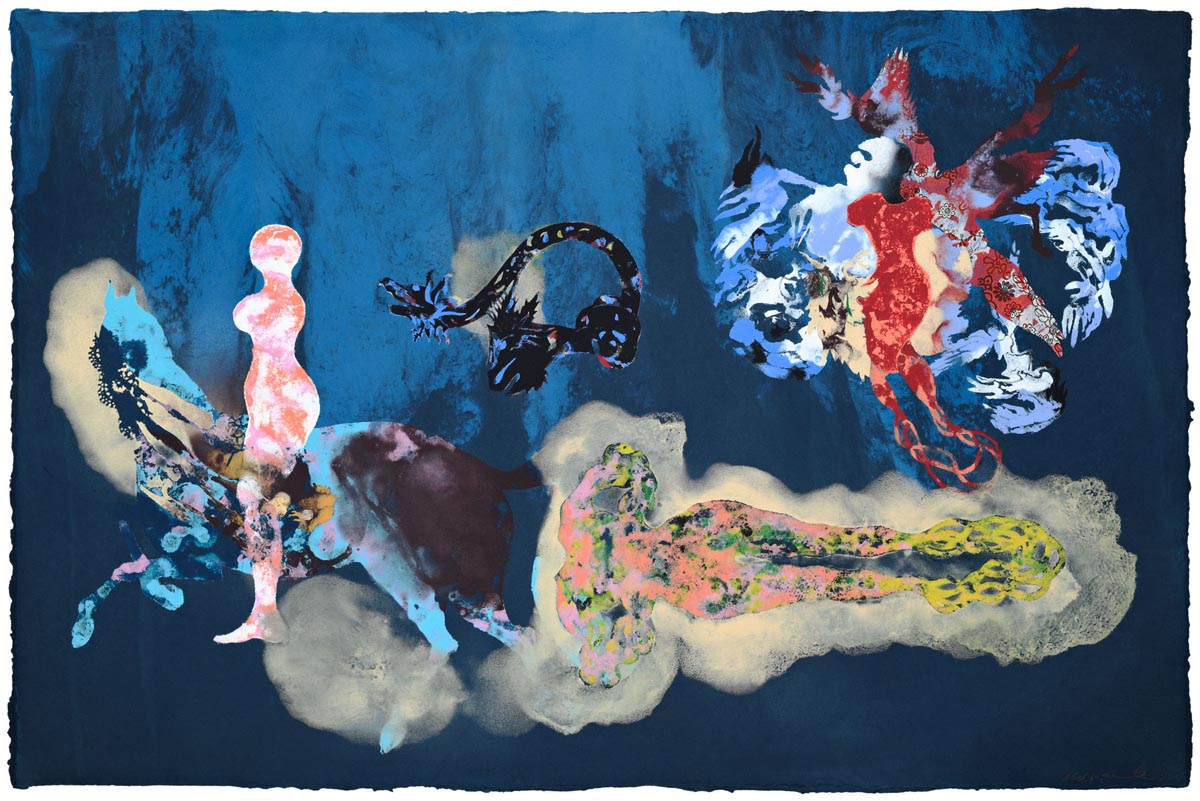
Shahzia Sikander (Pakistani and American, b. 1969), Baggage Warrior, 2024, pulp painted collagraph and watermarked pellon transfers with printed kozo inclusion and stenciled pulp painting on two color cotton background, Courtesy of the Artist and Pace Printers
Hi, I’m Ainsley Cameron, the museum’s curator of South Asian Art, Islamic Art, and Antiquities and the curator of Shahzia Sikander: Collective Behavior. I am reading the introduction to the exhibition.
For more than three decades, Shahzia Sikander (b. 1969 in Lahore, Pakistan) has been reframing South Asian visual histories through a contemporary perspective. Working in a variety of mediums—painting, drawing, print, digital animation, mosaic, sculpture, and glass—she reimagines the past for our present moment. She considers diasporic experiences, histories of colonialism, and Western relations with the Global South and the wider Islamic world, often through the lens of gender and body politics. At times, Sikander reflects on her own experience as an immigrant and diasporic artist working in the United States.
Rather than proceeding chronologically, the exhibition follows primary ideas and inquiries throughout her practice, rooted as they are in a recurring vocabulary of forms, figures, and ideas. The exhibition explores her role as an American artist, a Pakistani artist, a Muslim artist, a feminist artist, and, perhaps most significantly, as a global citizen engaging with a disrupted historical narrative.
Collective Behavior premiered as part of Venice’s Biennale Arte and was co-organized by the Cincinnati Art Museum (CAM) and the Cleveland Museum of Art. Complementary iterations of the exhibition are now presented at both Ohio museums. CAM’s exhibition is the largest, most comprehensive showing of Sikander’s work to date.
Shahzia Sikander – A Brief Biography
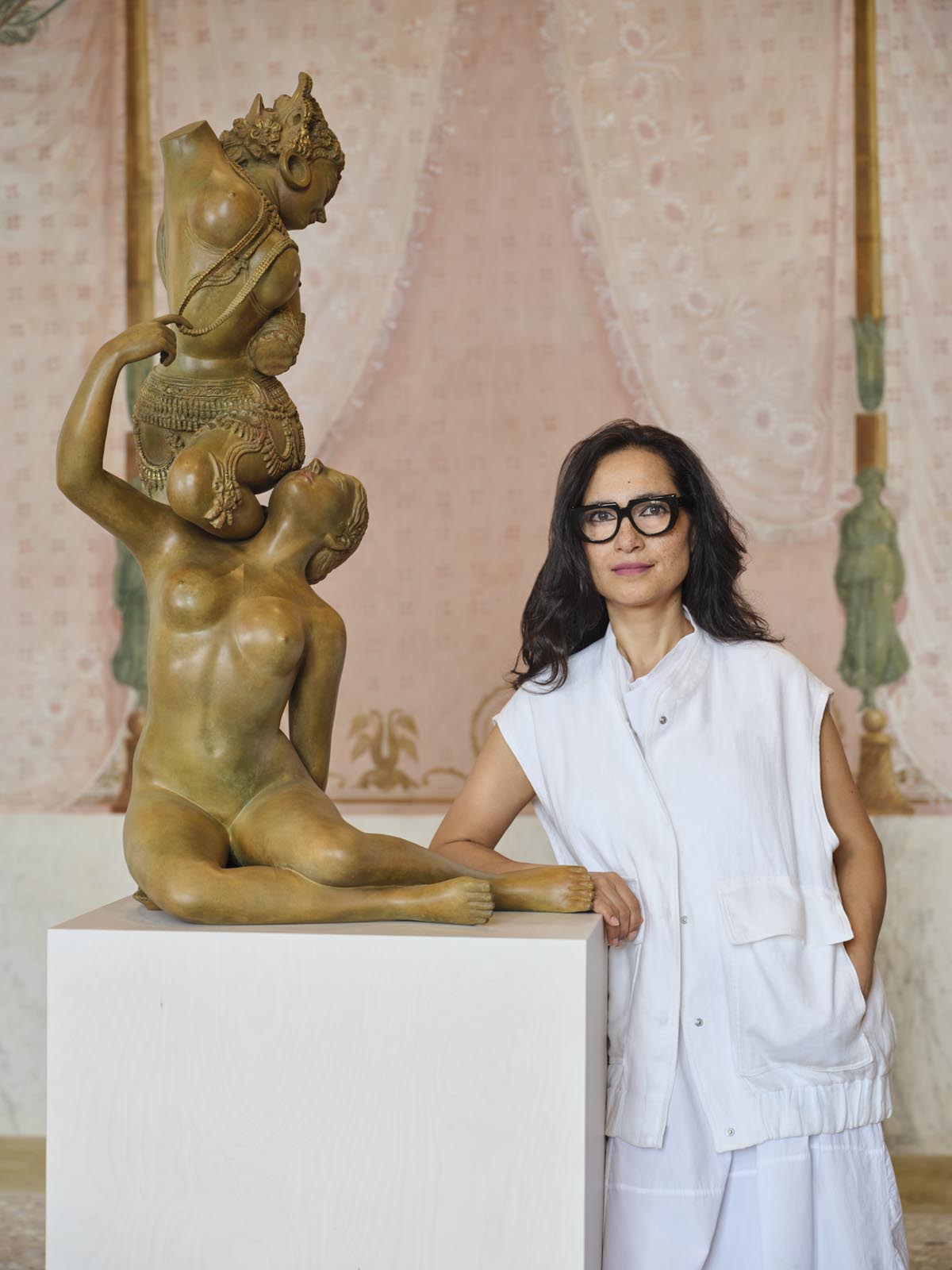
Photographer - Agostino Osio
Hi, I’m Ainsley Cameron, the museum’s curator of South Asian Art, Islamic Art, and Antiquities and the curator of Shahzia Sikander: Collective Behavior. I am reading Sikander’s biography.
Shahzia Sikander’s artistic training began in Lahore, Pakistan, where she studied historic manuscript painting at the National College of the Arts (NCA). Following her acclaimed undergraduate thesis project, The Scroll (1989–90), she became the first woman to teach in the NCA’s prestigious miniature painting department.
In 1993, Sikander moved to Providence, Rhode Island, to pursue graduate studies at the Rhode Island School of Design (RISD). After completing her MFA, Sikander relocated to Houston to participate in the Core Residency Program at the Museum of Fine Arts Houston’s Glassell School of Art from 1995 to 1997. She then moved to New York City, her primary base to date. Sikander has been the subject of numerous museum exhibitions, most recently Shahzia Sikander: Extraordinary Realities (organized by the RISD Museum). Awards include the MacArthur Foundation Fellowship ‘Genius’ Award (2006) and the Pollock Prize for Creativity, Pollock-Krasner Foundation (2023). Alongside her art practice, Sikander has taught continuously, including recent appointments at Brown University and Columbia University’s graduate programs.
NOW Artwork
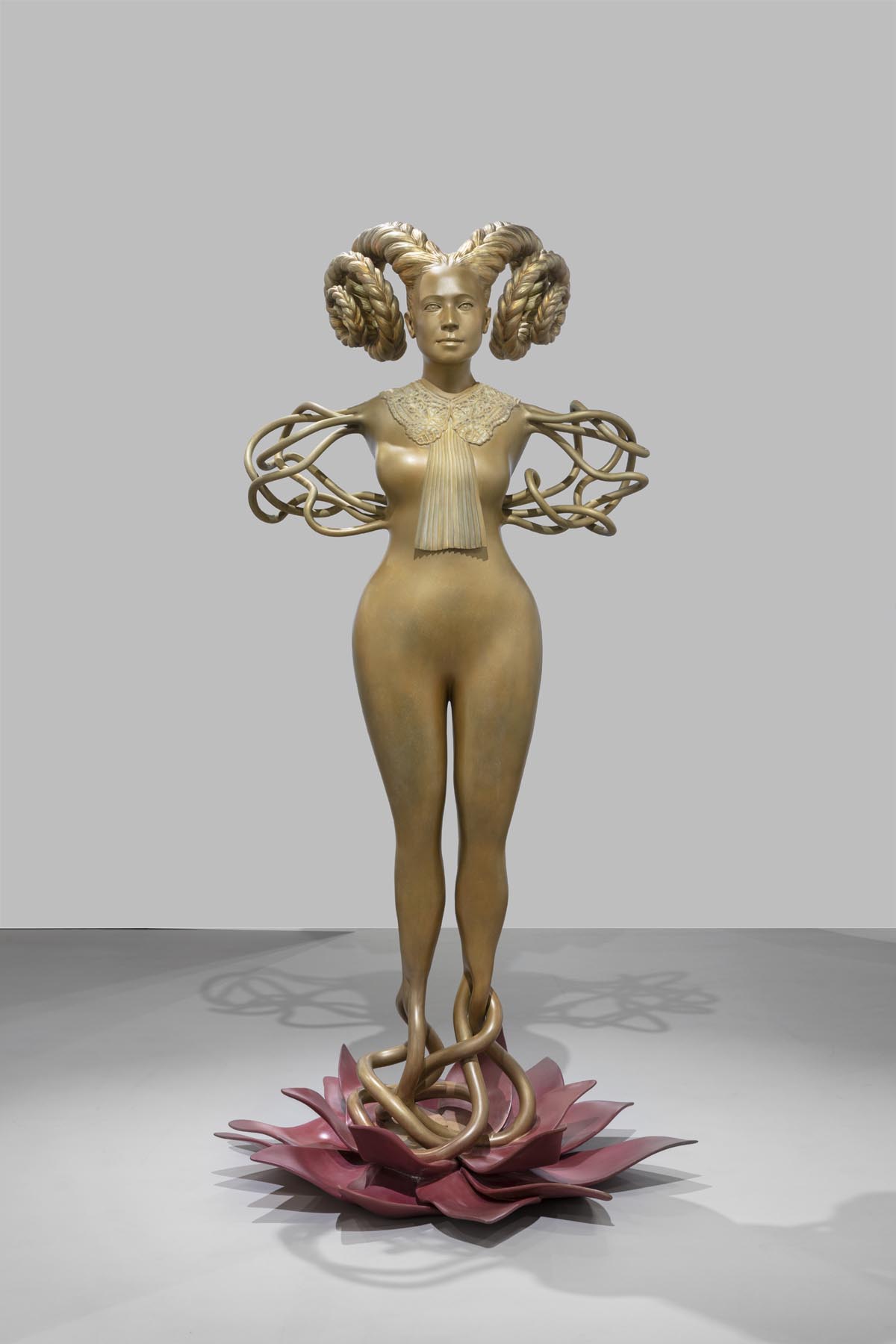
Shahzia Sikander (Pakistani and American, b. 1969), NOW, 2023, patinated bronze, Pizzuti Collection
97 1/2 x 49 x 49 in. (247.7 x 124.5 x 124.5 cm), 801 lbs.
Description
Hi, I’m Patrick O’Rourke and I am an animator who has collaborated with the artist. I am reading the description of NOW in Shahzia Sikander: Collective Behavior.
NOW, created in 2023, is a patinated bronze sculpture by Pakistani and American artist Shahzia Sikander (born 1969). It is in the Pizzuti Collection.
NOW is a three-dimensional vertically oriented patinated bronze sculpture. It measures 97 and one-half by 49 by 49 inches or 247.7 by 124.5 by 124.5 centimeters and weighs 801 pounds. In this work, a matte bronze female figure emerges from a dark pink lotus flower. Where feet would have been expected, three tentacles at the base of each leg twist and writhe together. As we move up the sculpture, the tentacle forms repeat, replacing the arms. Four on each side of the body, the tentacles twist and reattach at the figure’s hips.. Around her neck is an ornate, lacy collar with a pleated jabot extending to the navel. The figure’s face appears timeless, with no visible signs of aging. She looks forward with a slight smile on her face. Her long hair is braided into two curling ram horns, one on each side of her head.
Label
Hi, I’m Patrick O’Rourke and I am an animator who has collaborated with the artist. I am reading the description of NOW in Shahzia Sikander: Collective Behavior.
Now, created in 2023, is a patinated bronze sculpture by Pakistani and American artist Shahzia Sikander (born 1969). It is the Pizzuti Collection.
This sculpture reflects Sikander’s engagement with abstracted isolated forms that, through repetition and reinvention, have become closely identified with the artist’s practice over the last 30 years. The autonomous female form with tentacles instead of feet, the lotus base, and the hair presented as ram’s horns often recur in Sikander’s practice across various mediums: sculpture, works on paper, digital animations, mosaic, and glass. Here these forms combine with new elements, such as the collar motif most often associated with American Supreme Court Justice Ruth Bader Ginsberg. Through such reinvention, Sikander explores new ways of seeing and thinking about complex histories and current political ideologies that target feminine strength.
Sikander, reflecting on her practice, said: “Representing women as active agents in traditionally patriarchal spaces, especially spaces related to delivering justice and adjudicating power, seems necessary in contemporary civic life.
Exhibition Section: Point of Departure
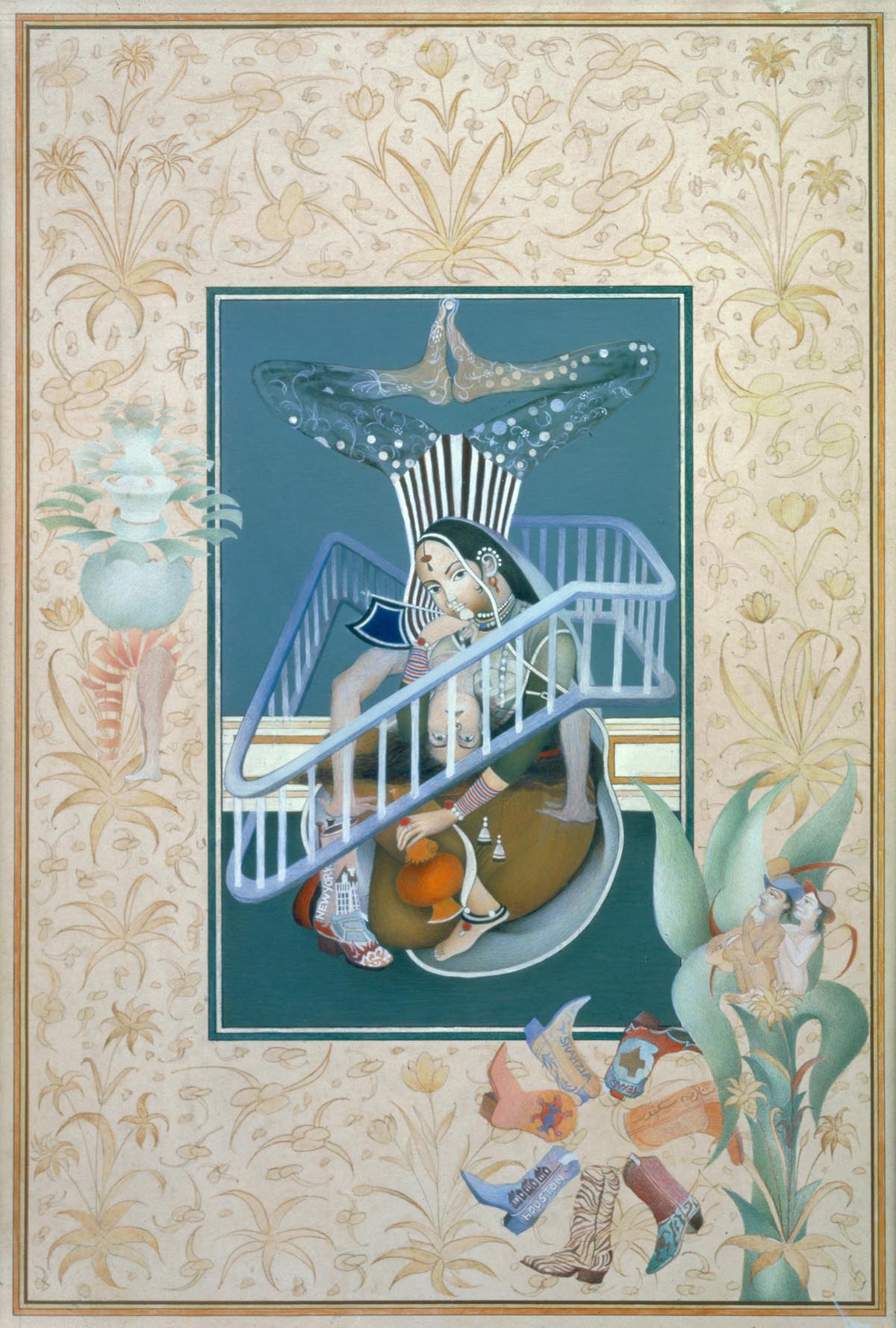
Shahzia Sikander (Pakistani and American, b. 1969), Elusive Realities, 1989–2000, vegetable color, dry pigment, watercolor, tea, and collage on wasli paper; The Speyer Family Collection, New York
Hi, I’m Trudy Gaba, curator of social justice at the National Underground Railroad Freedom Center. I am reading the “Point of Departure” section label in Shahzia Sikander: Collective Behavior.
This career-spanning exhibition is the largest and most comprehensive presentation of Shahzia Sikander’s practice. Works in this section demonstrate her ongoing engagement with South Asian, Persian, and Central Asian historic manuscript illustrations. Often referred to as “miniature painting,” a term borrowed from the Western art historical canon to refer to small jewel-like works of art, the term is now questioned and often cast aside by painting scholars as a colonial reflection on a significant historical and cultural record. Since she was a student of the renowned painter Bashir Ahmed at the National College of Arts in Lahore, Pakistan, Sikander has been a leader in the contemporary revival of manuscript painting. Her practice integrates historic inspiration while challenging longstanding conventions and reinventing the medium’s technical, aesthetic, and thematic framework.
Elsewhere, Sikander disrupts the histories of manuscript painting through playful uses of language and by breaking away from the page entirely through digital animation and mosaics. Her insightful works, created first in Lahore and later in the United States, have continued to reconfigure the boundaries of the “contemporary miniature.” While Sikander’s art learns from the past, it imagines new possibilities for the future.
Usurpia Artwork
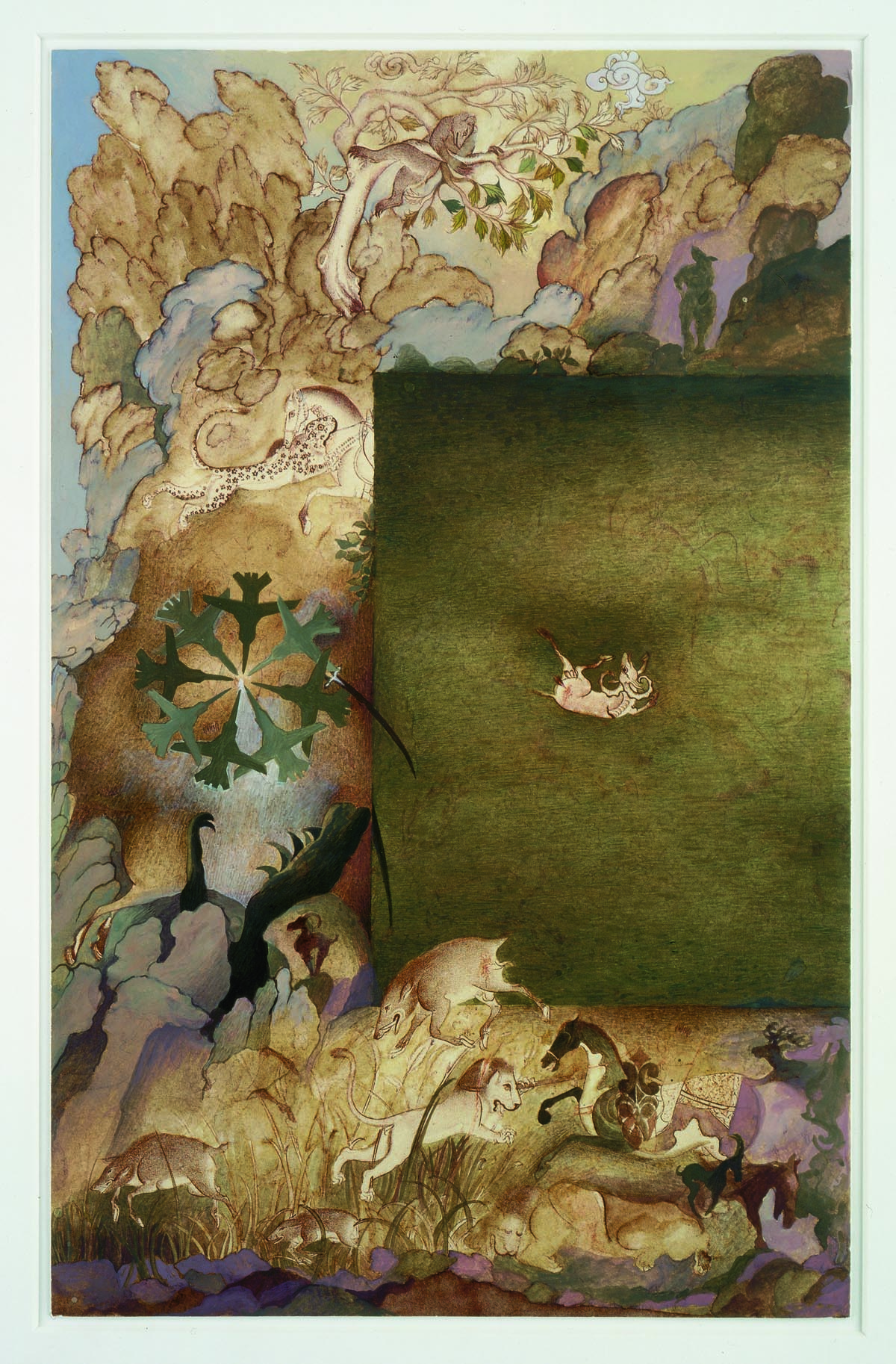
Shahzia Sikander (Pakistani and American, b. 1969), Usurpia, 2002, watercolor, dry pigment on wasli paper; Anu and Arjun Aggarwal
14 x 8 3/4 in. (35.5 x 22.2 cm)
Description
Hi, I’m Trudy Gaba, curator of social justice at the National Underground Railroad Freedom Center. I am reading the description of Usurpia in Shahzia Sikander: Collective Behavior.
Painted in 2002, Usurpia is watercolor and dry pigment on wasli paper. It is by Shahzia Sikander, a Pakistani and American artist born in 1969. It is in the exhibition courtesy of Anu and Arjun Aggarwal.
Usurpia is a vertically oriented watercolor and dry pigment painting on wasli paper. It measures 14 by eight and three-quarter inches or 35.5 by 22.2 centimeters. This work focuses on the olive-green vertical rectangular space stretching along the right side and into the center of the scene. In this space's center, a ram lies twisted on his side. Faint calligraphic lines in red are also evident. Framing this focal point at the top, left, and bottom are fantastical images of trees and mountains in shades of brown, lavender, and gray. Various animals are interspersed within these natural elements, including a bear in a tree at the top of the composition, a cheetah attacking a horse along the left side, and eight fighter jets forming a circle with their noses pointing to the center. Wild boars, lions, rams, a horse and a deer with antlers in various movement attitudes are present along the bottom landscape.
Label
Hi, I’m Trudy Gaba, curator of social justice at the National Underground Railroad Freedom Center. I am reading the label for Usurpia in Shahzia Sikander: Collective Behavior.
Painted in 2002, Usurpia is watercolor and dry pigment on wasli paper. It is by Shahzia Sikander, a Pakistani and American artist born in 1969. It is in the exhibition courtesy of Anu and Arjun Aggarwal.
Usurpia is a significant work that reflects Sikander’s engagement with South Asian and Persian manuscripts. Here, the artist transforms the format of a manuscript page through her playful reinvention, with unexpected additions and subtle omissions. Upending the expected balance of text contained within an illuminated border, Sikander paints a deep expanse of green pigment in place of text, empty but for the writhing form of a ram and the traces of calligraphic line. The border of the page teems with animal figures, rocky landscapes, and symbols of warfare, dominance, and power. Through this subtle reinvention of form where the margins (and marginalized) are centered, Usurpia conveys that history cannot always be contained.
Referring to her artistic practice, Sikander said: “My work takes on multiple vantage points, while always remaining cognizant of categories, hierarchies, and center-margin dynamics. It explores the intimacy and violence that arises between languages and cultures.”
The Scroll Artwork

Shahzia Sikander (Pakistani and American, b. 1969), The Scroll, 1989–1990, vegetable color, dry pigment, watercolor, and tea on wasli paper; Collection of the Artist, Courtesy of Shahzia Sikander and Sean Kelly, New York/Los Angeles
sheet 13 1/2 x 63 7/8 in. (34.3 x 162.2 cm)
Description
Hi, I’m Claire Flath, a preparator at the museum. I am reading the description of The Scroll in Shahzia Sikander: Collective Behavior.
Shahzia Sikander, a Pakistani and American artist born in 1969, created The Scroll from 1989 to 1990. It is vegetable color, dry pigment, watercolor and tea on wasli paper. It is in the artist’s collection and in the exhibition courtesy of Shahzia Sikander and Sean Kelly, New York and Los Angeles.
The Scroll is a long, horizontally oriented vegetable color, dry pigment, watercolor and tea on wasli paper painting. It measures 13 and one-half by 63 and seven-eighths inches or 34.3 by 162.2 centimeters. The painting is composed of various smaller scenes set within a large, rambling house. The house consists of an entryway, interior courtyards, and rooms on the first and second floor, all of which are visible to the viewer. The same figure of a young woman, always painted with her face turned away from us and hidden by her long hair, is portrayed over 20 times walking through different rooms. Sometimes her figure is semi-transparent, like she’s invisible or evaporating. First, the young woman enters the home on the far left of the painting. Then, she moves through several doorways and rooms, including a dining room, living room, several bedrooms, and a garden courtyard. There are many other people in the home, some reading, cleaning, playing, packing suitcases, talking, cooking, and eating. No one interacts with the young woman as she walks through. In the final scene, on the far-right side of the painting, the young woman stands at an artist’s easel painting the portrait of the young woman, who is also sitting in a chair posing for the portrait.
Label
Hi, I’m Hi, I’m Claire Flath, a preparator at the museum. I am reading the label for The Scroll in Shahzia Sikander: Collective Behavior.
Shahzia Sikander, a Pakistani and American artist born in 1969, created The Scroll from 1989 to 1990. It is vegetable color, dry pigment, watercolor and tea on wasli paper. It is in the artist’s collection and in the exhibition courtesy of Shahzia Sikander and Sean Kelly, New York and Los Angeles.
As her thesis project at the National College of Arts, Lahore, The Scroll brought Sikander international recognition for its significant break from ”traditional” painting. The work is more than five feet long, dimensions that greatly exceed the size and format of historic manuscript painting. Time and three-dimensional space enter the work; one must physically move to assimilate the work’s pieces and follow the narrative as it unfolds, almost cinematically. The work centers on the artist as an adolescent who came of age during Zia-ul-Haq’s military dictatorship (1978–88). With her back to us, this young girl wanders like a ghost through a domestic setting, one inspired by historic Safavid paintings and contemporary Pakistani architecture. The work explores domesticity as a feminist space, highlights class and gender disparities, and is imbued with a sense of mystery. The haunting presence of the protagonist troubles and disquiets, as Sikander herself does in her approach to the histories she reconfigures.
Provenance the Invisible Hand Artwork
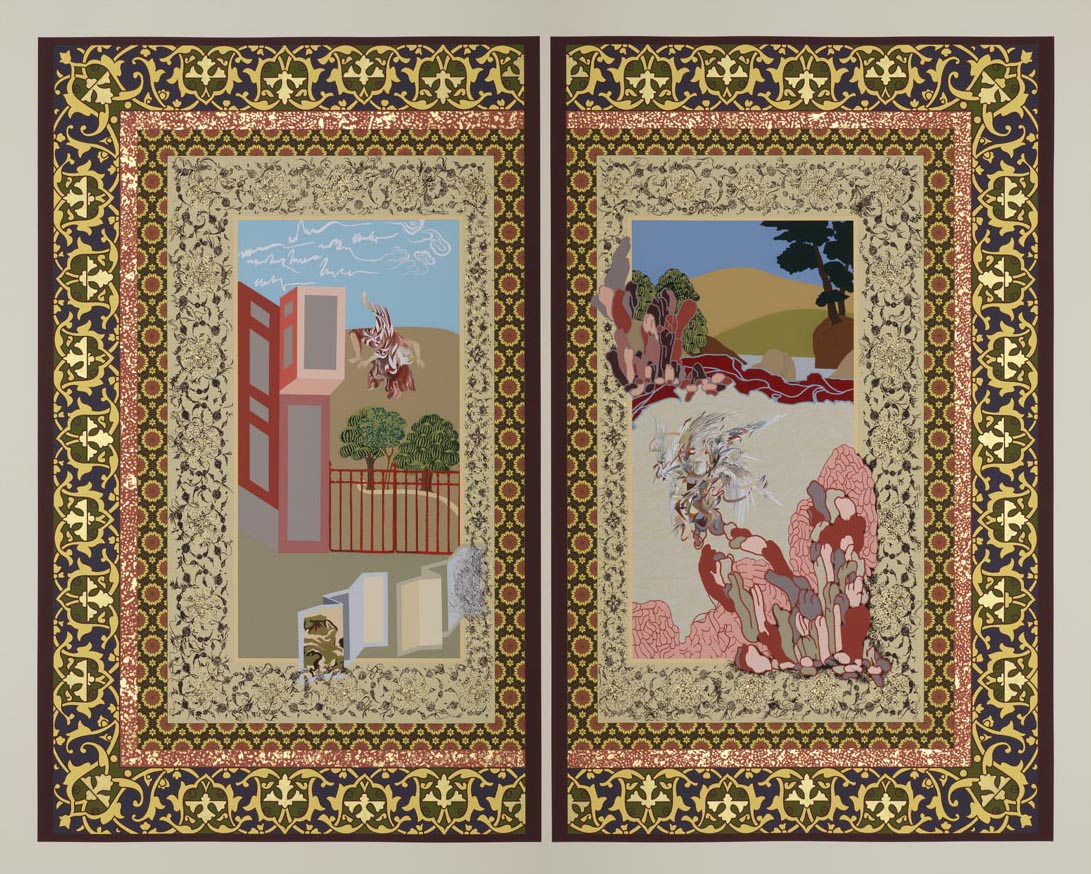
Shahzia Sikander (Pakistani and American, b. 1969), Provenance the Invisible Hand from the series The Illustrated Page, 2009, opaque watercolor hand painting, gold leaf, and silkscreened pigment on paper (diptych); Collection of the Artist, Courtesy of Shahzia Sikander and Sean Kelly, New York/Los Angeles
56 5/8 × 71 15/16 × 1 1/2 in. (143.8 × 182.7 × 3.8 cm)
Description
Hi, I’m Colleen Houston, chief executive office and artistic director at ArtWorks. I am reading the description of Provenance the Invisible Hand from the series The Illustrated Page in Shahzia Sikander: Collective Behavior.
The diptych, Provenance the Invisible Hand from The Illustrated Page series, is opaque watercolor hand painting, gold leaf, and silkscreened pigment on paper. It was created in 2009 by Shahzia Sikander, a Pakistani and American artist born in 1969. It is in the artist’s collection and in the exhibition courtesy of Shahzia Sikander and Sean Kelly, New York and Los Angeles.
Provenance the Invisible Hand from The Illustrated Page series is a diptych comprised of two vertically oriented opaque watercolor hand paintings on paper with gold leaf and silkscreened pigment. It measures 56 and five-eighths by 71 and fifteen-sixteenths by one and one-half inches or 143.8 by 182.7 by 3.8 centimeters—four rectangular bands frame the central image on each side of this diptych. Moving from the outside of the work to the center, the first framing band is wide and comprised of interlocking vines of light green, olive green, and pale yellow on a dark blue ground. The next frame is narrow and has a speckled appearance of red on cream. Moving inward, the third frame is decorated with a series of daisy-like mosaic patterns of red, gold, and brown. The final frame is an airy floral arrangement in black and cream on a beige background.
The left central image depicts an exterior space with a modern structure on the left with a red fence in the midground, creating a courtyard space in the background. Behind the fence are two green trees. Above the structure is a bright blue sky with sketchy white clouds. As if falling backward off the structure, a figure wrapped in a burgundy and white textile with a bald eagle head headpiece falls from the sky to the courtyard below. In the foreground, there are two tri-fold room screens, the forward post panel decorated in camouflage. The screen extends into the most inward border.
The image on the right is also an exterior space. In the background, a tan and a green mountain rises under a medium-blue sky. In front of this is a small body of water with a tall brown rock with trees growing out of it on the right and another on the left, also with trees. Moving into the foreground is an open space surrounded by red, pink, gray, and burgundy rocks or plants. The focal point of this scene is the hovering bald eagle figure with flapping white, brown, and blue wings and human legs and feet. The wings are repeated and layered over each other to indicate movement.
Label
Hi, I’m Colleen Houston, chief executive office and artistic director at ArtWorks. I am reading the label for Provenance the Invisible Hand from the series The Illustrated Page in Shahzia Sikander: Collective Behavior.
The diptych, Provenance the Invisible Hand from The Illustrated Page series, is opaque watercolor hand painting, gold leaf, and silkscreened pigment on paper. It was created in 2009 by Shahzia Sikander, a Pakistani and American artist born in 1969. It is in the artist’s collection and in the exhibition courtesy of Shahzia Sikander and Sean Kelly, New York and Los Angeles.
This diptych evokes two pages of an open manuscript. Whereas the historic manuscript format referenced would have been handheld, Sikander plays with scale, disrupting the preciousness of a one-of-a-kind illustrated and illuminated manuscript through size and the medium of print.
Sikander created this work for inclusion in a 2009 show she curated at the Cooper Hewitt National Design Museum in New York City. The exhibition brought together Jacquard silks, shikasta (broken script) calligraphy, Japanese scrolls, prints by Francisco Jose de Goya, and historic British and Persian manuscripts. Seen together, these works helped to unlock the viewing process across geography, time, and political reference points. Similarly, Provenance the Invisible Hand incorporates multiple historical and contemporary reference points in one cohesive artwork.
Sikander, in reference to her research-based approach, said: “Identifying, dismantling and transforming nineteenth and twentieth scholarship around tradition, Orientalism, and nostalgia through a discursive and feminist lens captured my imagination and became my hunger.”
Perilous Order Artwork
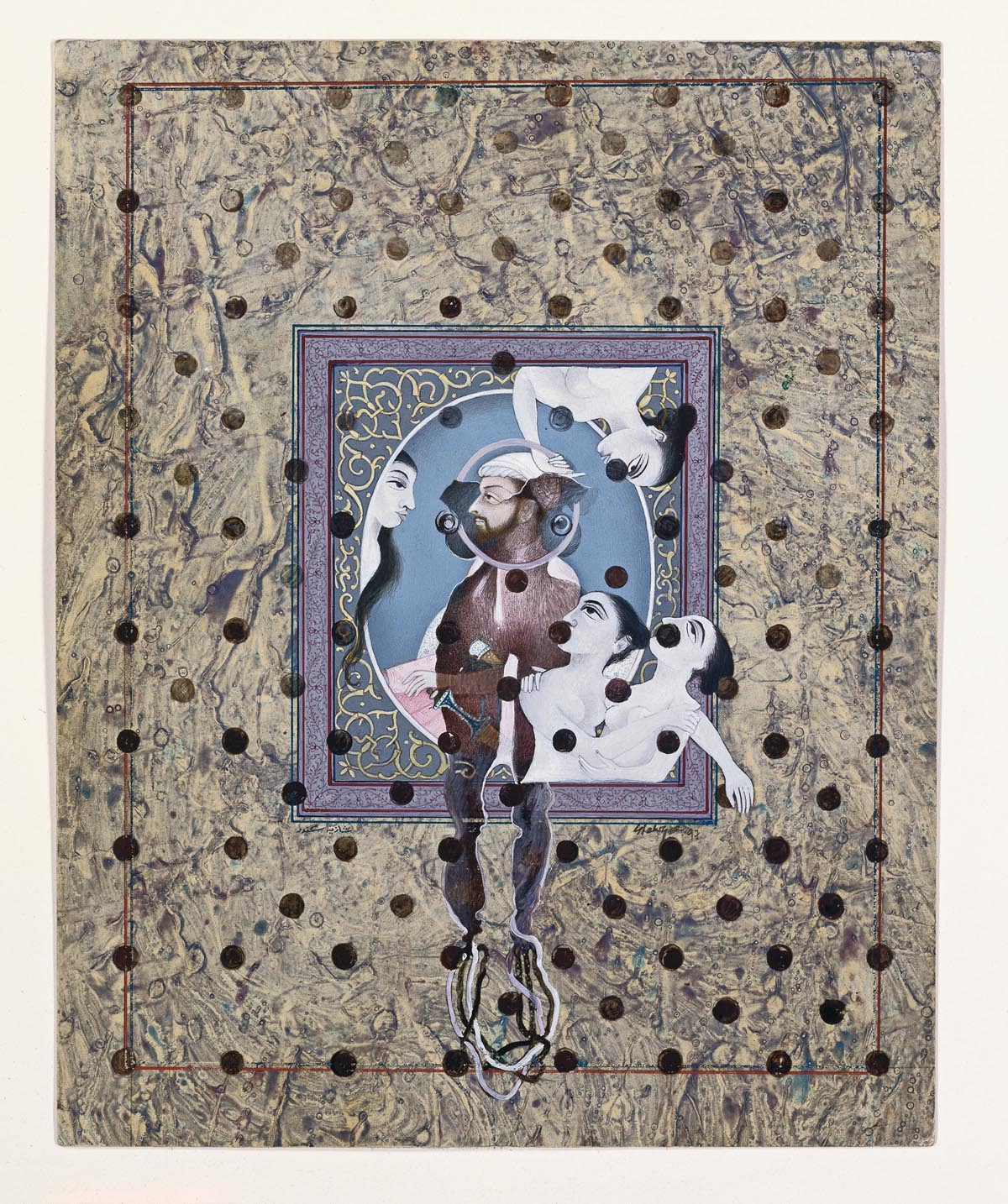
Shahzia Sikander (Pakistani and American, b. 1969), Perilous Order, 1989–1997, transparent and opaque watercolor, tea, and charcoal on marbled board; Whitney Museum of American Art, New York; purchase, with funds from the Drawing Committee, 97.83.2
10 3/8 x 8 3/16 in. (26.4 x 20.8 cm)
Description
Hi, I’m Colleen Houston, chief executive office and artistic director at ArtWorks. I am reading the description of Perilous Order in Shahzia Sikander: Collective Behavior.
Shahzia Sikander, a Pakistani and American artist born in 1969, created Perilous Order between 1989 and 1997. It is transparent and opaque watercolor, tea, and charcoal on marbled board. It is in the Whitney Museum of American Art, New York collection and purchased with funds from the Drawing Committee. The museum registration number is 97.83.2.
Perilous Order is a vertically oriented transparent and opaque watercolor, tea, and charcoal on marbled board painting. It measures ten and three-eighths by eight and three-sixteenths inches or 26.4 by 20.8 centimeters. The central figures in this work overflow the oval periwinkle-blue frame. The man in the center sits in profile, facing the left. Appearing to be in his 20’s or 30’s, the man has a closely trimmed dark beard and mustache. He wears a white turban and a high-collared white tunic and wears one earring on his left ear. He has a sword with a blue hilt resting on his hip. Overlaid on this figure is a shadowed figure of a female torso with tentacles as feet.
Surrounding this figure are four nude women with long dark hair. In the upper right, a woman, only her head and upper torso evident, is upside down, her left hand near the man’s head and pointing at her face. In the lower right corner, two women embrace while looking up. The fourth woman, her hair flowing down beyond the borders of the frame, peeks out from the left and faces the man.
A wide rectangular frame resembling marbled paper with blue veining, followed by another smaller frame with red, vinelike embellishments on a purple background, and finally an oval frame of gold vine-like tendrils on blue surrounds the central figures. A scattering of black polka dots haphazardly decorates the page.
Label
Hi, I’m Colleen Houston, chief executive office and artistic director at ArtWorks. I am reading the label for Perilous Order in Shahzia Sikander: Collective Behavior.
Shahzia Sikander, a Pakistani and American artist born in 1969, created Perilous Order between 1989 and 1997. It is transparent and opaque watercolor, tea, and charcoal on marbled board. It is in the Whitney Museum of American Art, New York collection and purchased with funds from the Drawing Committee. The registration number is 97.83.2.
Sikander plays with language in her titles to offer a clue, provoke, or to riddle. In Perilous Order, the artist considers how relying on natural or cultural order is unsafe. She explores these ideas through formal and stylistic attributes, as well as through gender and sexuality. Originally created when she lived in Pakistan, the central figure is based on a close friend; the gold earring identifies him as a gay man. The oval portrait format resonates with historic forms and speaks to male sovereignty, yet the addition of female forms—portrayed individually yet understood as a collective—interrupts the composition. Sikander added the polka dots years after she considered the painting complete. The dots first look like a grid but are all individually placed, slightly askew. As a whole, there is a tension between the different elements in Perilous Order, and yet everything fits, despite the inherent chaos.
Riding the Written Artwork
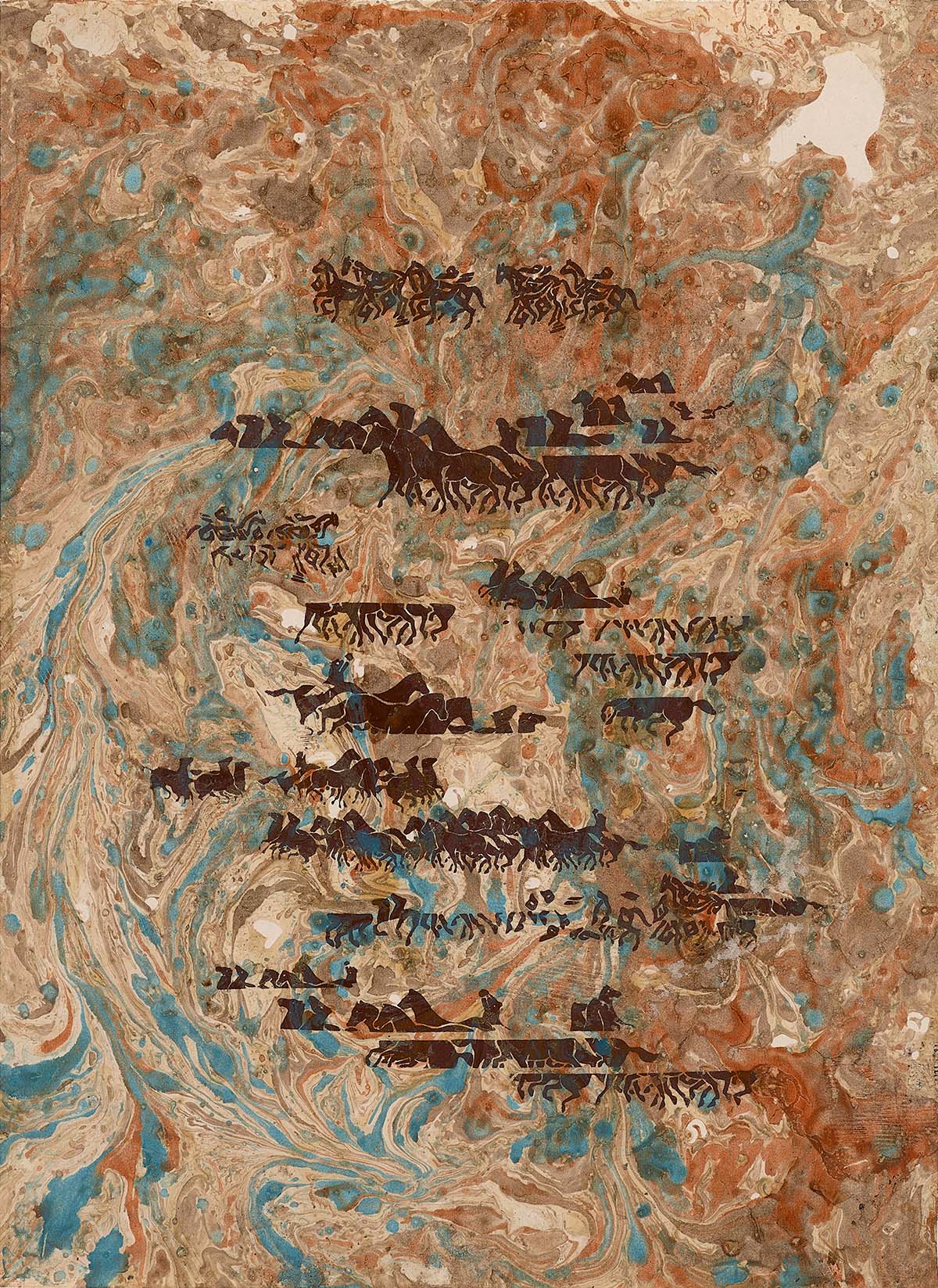
Shahzia Sikander (Pakistani and American, b. 1969), Riding the Written, 1992, screenprint over handmade marbled paper, Collection of the Artist, Courtesy of Shahzia Sikander and Sean Kelly, New York/Los Angeles
14 13/16 x 11 5/16 in. (37.7 x 28.8 cm)
Description
Hi, I’m Shakila Ahmad, Emeritus Board Chair for the Islamic Center of Greater Cincinnati. I am reading the description of Riding the Written in Shahzia Sikander: Collective Behavior.
Riding the Written, from 1992, is a screenprint over handmade marbled paper. It was created by Shahzia Sikander, a Pakistani and American artist born in 1969. It is in the artist’s collection and in the exhibition courtesy of Shahzia Sikander and Sean Kelly, New York and Los Angeles.
Riding the Written is a vertically oriented screenprint over handmade marbled paper. It measures 14 and thirteen-sixteenths by 11 and five-sixteenths inches or 37.7 by 28.8 centimeters. The imagery running along the center of this work appears to be a flowing, Arabic calligraphic writing. However, upon closer inspection, the small, screen-printed figures are herds of brown horses, some fragmented, some with riders, charging back and forth on a ground of blue, brown, and tan marbled paper.
Label
Hi, I’m Shakila Ahmad, Board Chair for the Islamic Center of Greater Cincinnati. I am reading the label for Riding the Written in Shahzia Sikander: Collective Behavior.
Riding the Written, from 1992, is a screenprint over handmade marbled paper. It was created by Shahzia Sikander, a Pakistani and American artist born in 1969. It is in the artist’s collection and in the exhibition courtesy of Shahzia Sikander and Sean Kelly, New York and Los Angeles.
Referencing her lived experience in America, Sikander said: “Inhabiting the feminine and Asian American in the West often means living the paradox of being invisible while standing out. Language is both a connecting thread and an embodiment of this position. So, I like to push beyond writing in my use of script—to think of how Arabic, Urdu, and English calligraphy can transform visual relationships on the page.”
This print references a Qur’anic passage (Surah al-‘Adiyat (Chapter 100: The Chargers), verses 1–11) describing a scene of horses charging. Sikander’s use of Arabic calligraphy is inspired by childhood memories of memorizing and reciting the Qur’an. The written word, the significance of what is written, who is reading it, and how it is interpreted holds significance in Islam. The artist encourages us to look beyond the text and think about the visual relationships to language, calligraphic traditions, and the multiplicity and dissemination of the written word through printing.
Exhibition Section: The Feminine Space
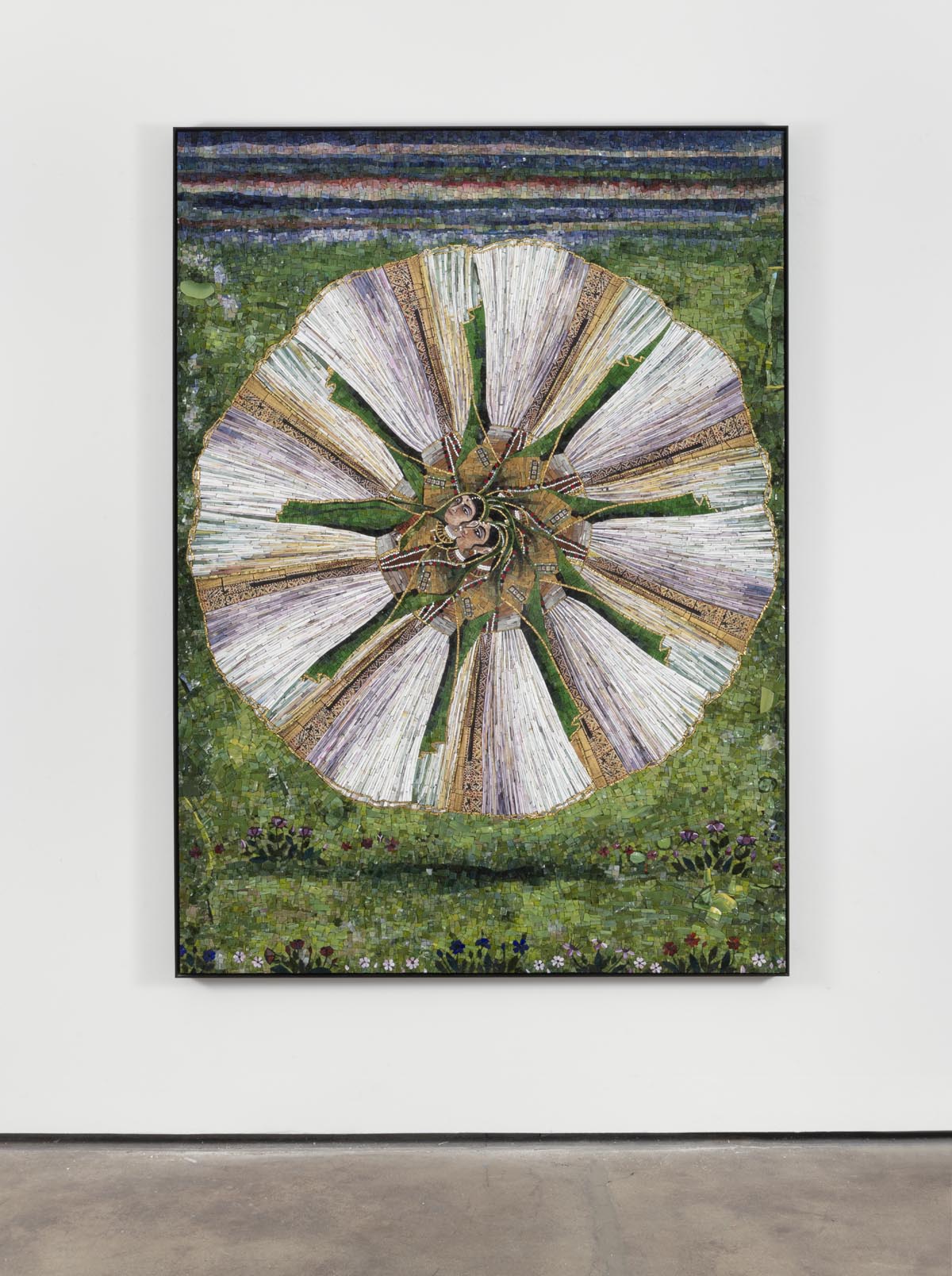
Shahzia Sikander (Pakistani and American, b. 1969), Arose, 2020, glass mosaic with patinated brass frame, Courtesy of Joel S. Pizzuti
Description
Hi, I’m Sarah Wenner, the museum's fellow for Ancient Mediterranean and Middle Eastern Art. I am reading “The Feminine Space” section label in Shahzia Sikander: Collective Behavior.
Sikander addresses gender and body politics through a dynamic vocabulary of forms that has evolved throughout her career. Since 1993, she has repeatedly rendered a nebulous floating female figure with a closed circuit of tentacles in place of feet. Hovering above the ground, the figure is visibly unrooted and, within Sikander’s cosmos, transcends the confines of geography, culture, religion, and time. The works in this section present different iterations of this figure and the ideas she embodies.
Just as this figure has floated throughout Sikander’s work for over 30 years, other motifs recur to manifest a powerful female presence. Gopis, female devotees of the Hindu god Krishna and the visual manifestation of a soul’s desire to unite with the divine, appear often in South Asian painting. Sikander extracts a physical detail, their hair, and replicates it repeatedly, constructing a potent, swarming, and energetic mass. These and other forms reappear throughout the exhibition, demonstrating how Sikander’s visual language layers music, movement, and cultural critique to create a collective energy.
A Slight and Pleasing Dislocation, II Artwork
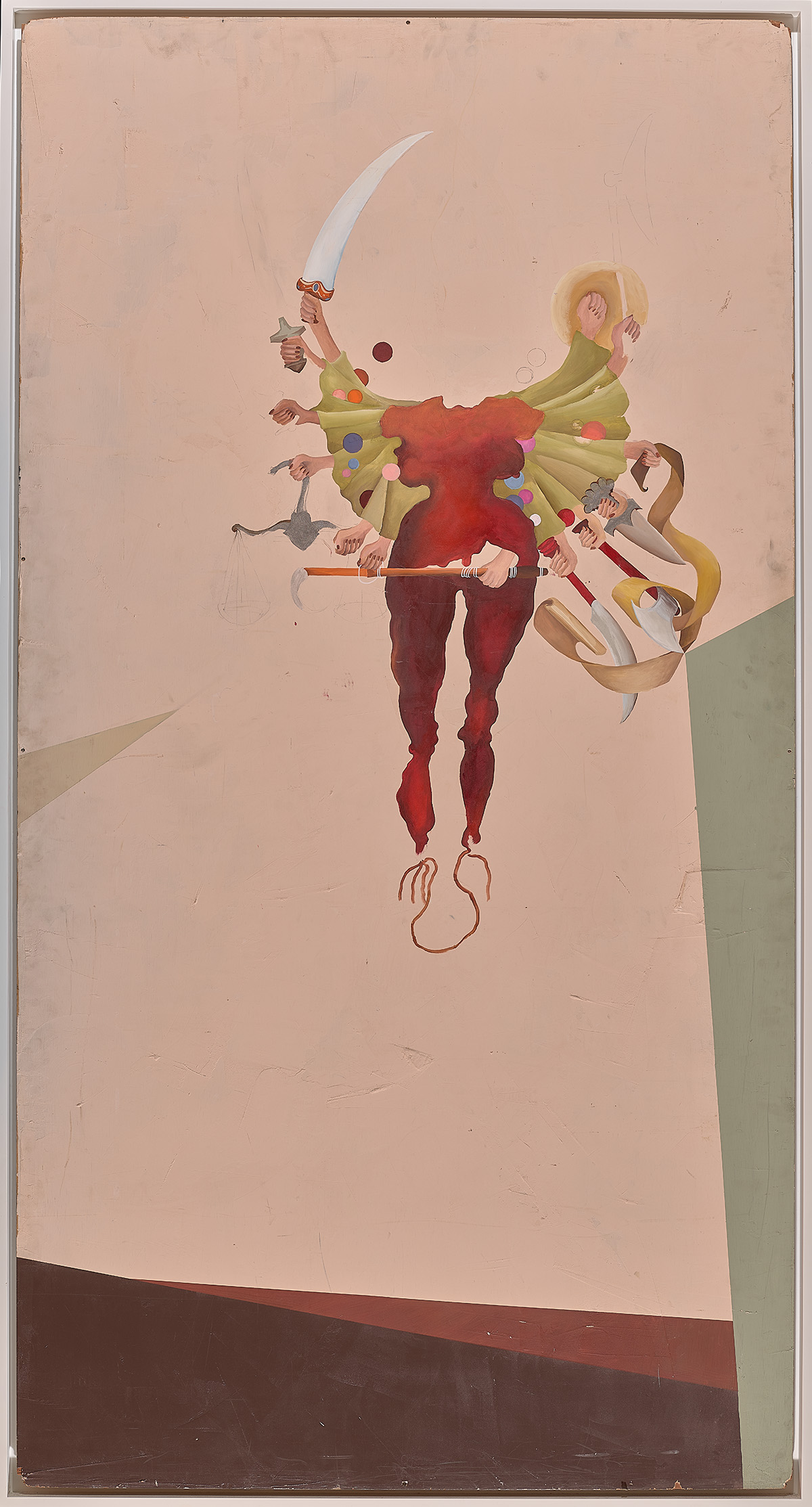
Shahzia Sikander (Pakistani and American, b. 1969), A Slight and Pleasing Dislocation, II; 2000–2001, acrylic on board, Collection of the Artist, Courtesy of Shahzia Sikander and Sean Kelly, New York/Los Angeles
Description
Hi, I’m Rose Milnes, the museum’s Curatorial Assistant for South Asian Art, Islamic Art, and Antiquities. I am reading the description of A Slight and Pleasing Dislocation, II in Shahzia Sikander: Collective Behavior.
Shahzia Sikander, a Pakistani and American artist born in 1969, painted A Slight and Pleasing Dislocation, II between 2000 and 2001. Acrylic on board, the work is in the artist's collection and in the exhibition courtesy of Shahzia Sikander and Sean Kelly, New York and Los Angeles.
A Slight and Pleasing Dislocation, II is a large vertically oriented acrylic on board painting. It measures 94 by 50 and five-eighths by one and five-eighths inches or 238.8 by 128.3 by 3.8 centimeters. A headless female figure, shaded in various reds and oranges with thirteen arms covered in flowing light green sleeves, hands with painted fingernails, and tentacles for feet hovers on a beige background. The arms fan out around the figure. Below the form, along the right side of the painting, is a long, narrow triangle-like shape, and to her left, another smaller tan triangle. Along the bottom of the composition is a slanted dark red and burgundy rectangular shape. A smattering of multi-colored polka dots embellishes the form.
Examining the hands more closely, moving clockwise around the figure, the uppermost hand is in a fist and surrounded by a halo; the next holds a penciled-in axe on a long handle; the third hand grasps a brown and gold ribbon that trails around the following three hands; the fourth hand holds a dagger; the fifth another short-handled axed and the sixth a sword with a curved blade. The seventh and eighth hands hold a rod with a curved hook in front of the figure. The ninth and tenth hands hold a set of scales that have also been penciled in. The eleventh, twelfth, and thirteenth hands hold swords that are at first barely detectable and become more realized in the final hand.
Label
Hi, I’m Rose Milnes, the museum’s Curatorial Assistant for South Asian Art, Islamic Art, and Antiquities. I am reading the label for A Slight and Pleasing Dislocation, II in Shahzia Sikander: Collective Behavior.
Shahzia Sikander, a Pakistani and American artist born in 1969, painted A Slight and Pleasing Dislocation, II between 2000 and 2001. Acrylic on board, the work is in the artist's collection and in the exhibition courtesy of Shahzia Sikander and Sean Kelly, New York and Los Angeles.
This unfinished work was originally part of a commissioned mural at Skadden Arps Law firm in New York. The image re-envisioned the ubiquitous, Western art historical depiction of women and law seen through a non-Western lens. In the immediate aftermath of 9/11, those commissioning the mural viewed the sword-wielding figure as violent. Electing to walk away from the project, Sikander found it notable that a representation of a non-white female with a sword was seen as inherently aggressive.
Sikander often reflects on the shift in perception for non-white artists working in the U.S. In the late 1990s, New York City-based artists participated in an integrated, globally focused, and inclusive art scene. After 9/11, however, artists were more likely to be defined by their race or be associated with the national spaces of their birth or family ties. These geographic silos continue today, where Sikander is often referred to as a Pakistani artist without wider context.
A Slight and Pleasing Dislocation Artwork
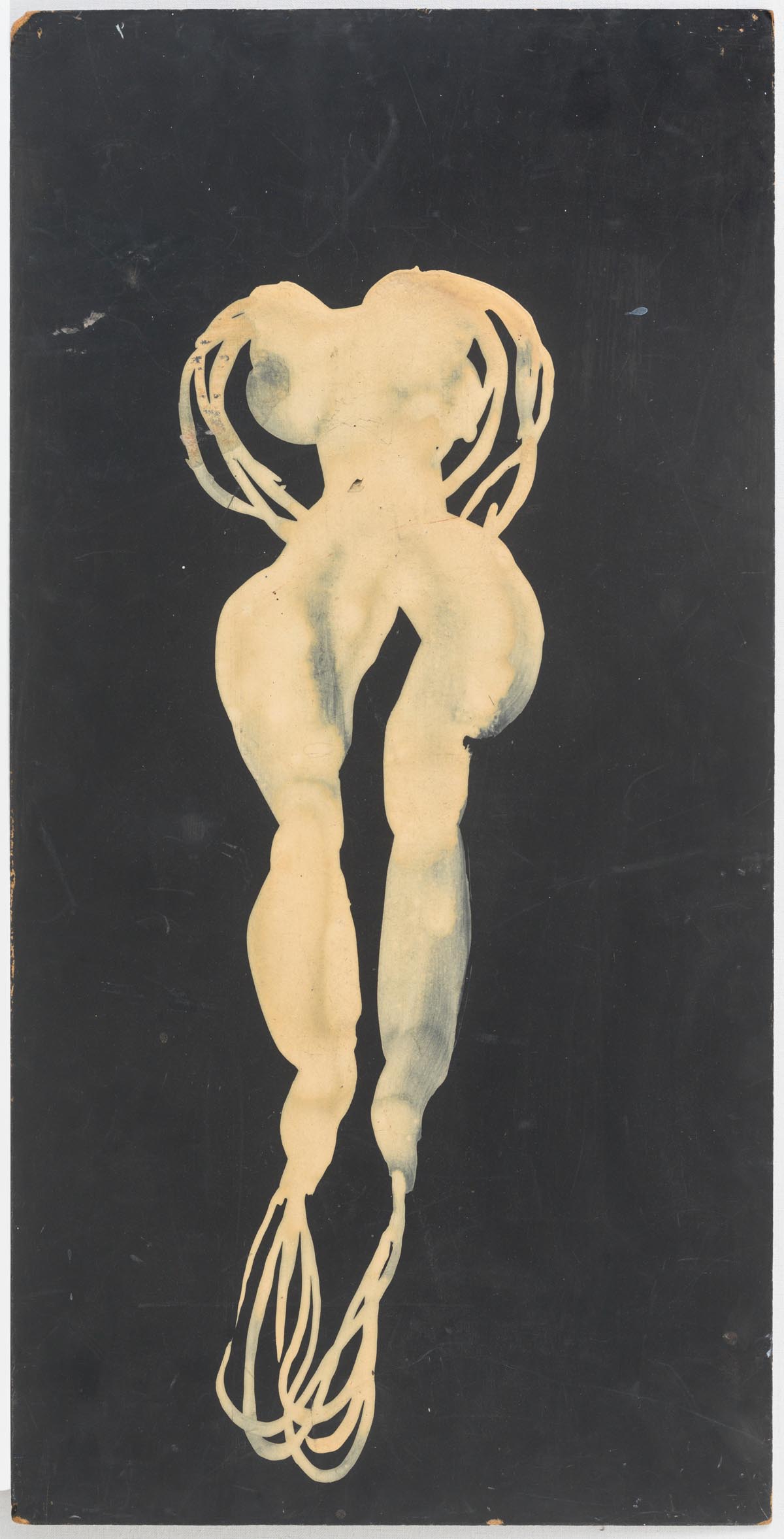
Shahzia Sikander (Pakistani and American, b. 1969), A Slight and Pleasing Dislocation, 1993, gouache and gesso on board, Cincinnati Art Museum, Alice Bimel Endowment for Asian Art, 2019.195
24 1/8 x 12 1/16 in. (61.2 x 30.7 cm)
Description
Hi, I’m Joe Civitello, the museum’s chief preparator. I am reading the description of A Slight and Pleasing Dislocation in Shahzia Sikander: Collective Behavior.
Shahzia Sikander, a Pakistani and American artist born in 1969, painted A Slight and Pleasing Dislocation in 1993. It is gouache and gesso on board. It is in the Cincinnati Art Museum’s collection, Alice Bimel Endowment for Asian Art. The registration number is 2019.195.
A Slight and Pleasing Dislocation is a vertically oriented gouache and gesso on board painting. It measures 24 and one-eighth by 12 and one-sixteenths inches or 61.2 by 30.7 centimeters. Hovering in the center of a mottled black ground, a headless female figure encompasses most of the composition. The figure’s arms are replaced by entwined tentacle-like forms, three on each side. They appear to come together at the waist behind the form’s back. Instead of feet, a repeat of the tentacle-like shapes creates three elongated tendrils on each leg.
Label
Hi, I’m Joe Civitello, the museum’s chief preparator. I am reading the label for A Slight and Pleasing Dislocation in Shahzia Sikander: Collective Behavior.
Shahzia Sikander, a Pakistani and American artist born in 1969, painted A Slight and Pleasing Dislocation in 1993. It is gouache and gesso on board. It is in the Cincinnati Art Museum’s collection, Alice Bimel Endowment for Asian Art. The registration number is 2019.195.
This floating figure with connected tentacles in place of feet is the artist’s manifestation of feminine power and presence. By creating and repeating this autonomous female figure, Sikander seeks to isolate the feminine from different cultures and religions, and to transcend the entrenched boundaries of femininity, culture, and temporal connections.
Painted as an MFA student at the Rhode Island School of Design (RISD), this is the first instance of Sikander’s iconic female form. Since then, the artist has experimented with size, scale, and media; it appears in works on paper, site-specific wall painting, digital animations, glass works, and stone mosaics.
Referencing this abstracted, floating figure, Sikander said: “Producing an outburst of androgynous forms, fragmented human bodies, headless torsos, and buoyant, self-rooted feminine figures that refused to belong, to be fixed or stereotyped were a response to my inability to locate Brown South Asian representations in art history books or in the predominantly white feminist spaces of the early 1990s.”
Pathology of Suspension Artwork
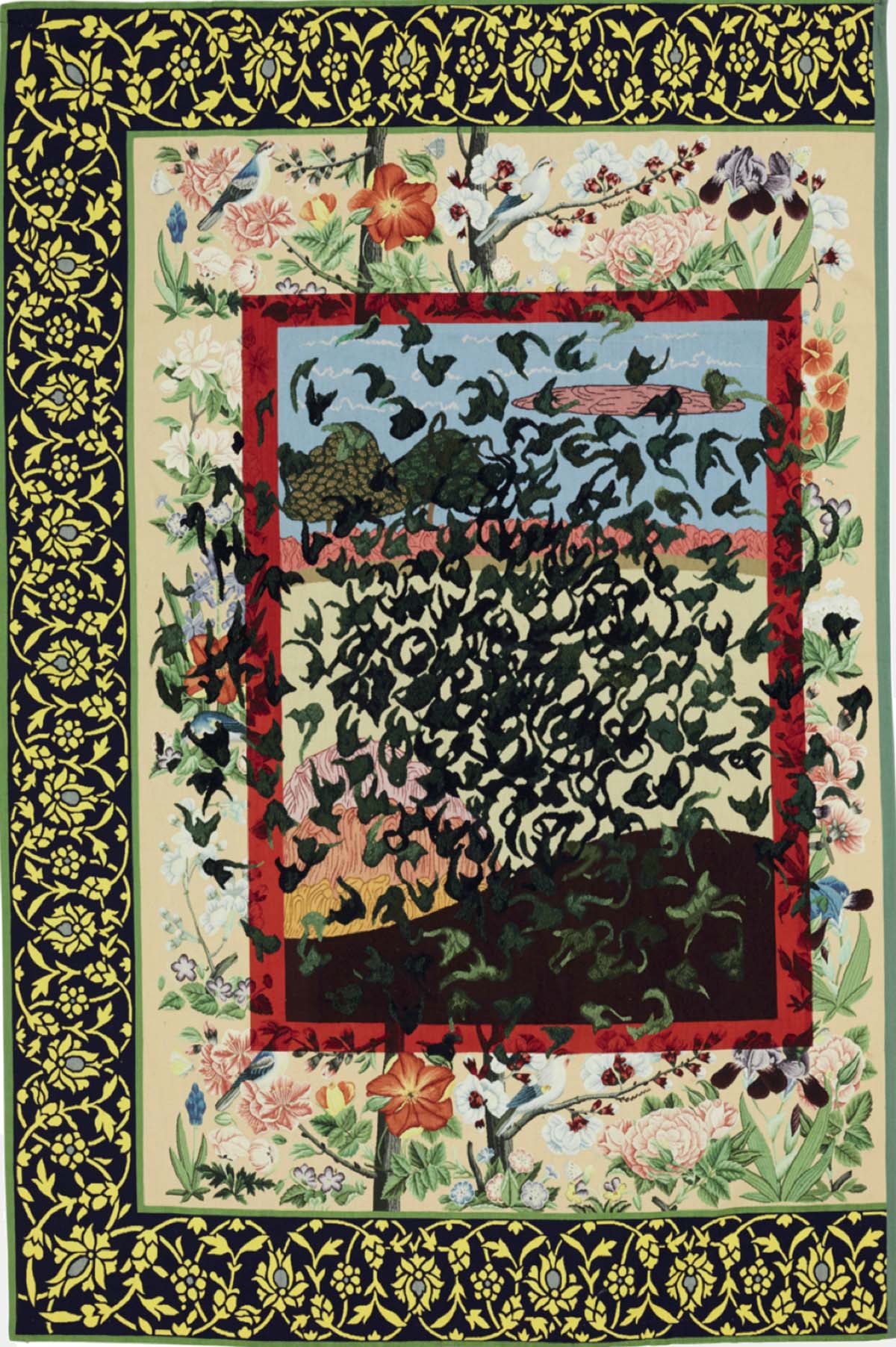
Shahzia Sikander (Pakistani and American, b. 1969), Pathology of Suspension, 2008, wool and silk tapestry with raised silk embroidery, Collection of the Artist, Courtesy of Shahzia Sikander and Sean Kelly, New York/Los Angeles
105 x 71 1/4 x 1/4 in. (266.7 x 180.9 x .6 cm)
Description
Hi, I’m Sarah Wenner, the museum's fellow for Ancient Mediterranean and Middle Eastern Art. I am reading the description of Pathology of Suspension in Shahzia Sikander: Collective Behavior.
Shahzia Sikander, a Pakistani and American artist born in 1969, created Pathology of Suspension in 2008. It is wool and silk tapestry with raised silk embroidery. It is in the artist’s collection and in the exhibition courtesy of Shahzia Sikander and Sean Kelly, New York and Los Angeles.
Pathology of Suspension is a large vertically oriented wool and silk tapestry with raised silk embroidery. It measures 105 by 71 and one-quarter by one-quarter inches or 266.7 by 108.9 by .6 centimeters. Moving from the outside to the center of this composition, an intertwining floral motif in bright yellow on a black background frames the work on three sides – top, bottom, and left. Another botanical frame of green leaves, orange daylilies, dark purple and white irises, light pink carnations, white lilies, blue crocuses, and white cherry blossoms on branches, upon which several birds perch, are evident on a beige ground. The central image, framed in a solid red band that allows the previously mentioned border to seep through, depicts an abstract landscape with green trees, rolling hills, and mountains under a blue sky. Over the entirety of this scene and the innermost borders, what appears to be a swarm of tiny black birds is, in fact, the hair of gopis (female devotees of the Hindu god Krishna).
Label
Hi, I’m Emily Liebert, the Lauren Rich Fine Curator of Contemporary Art at the Cleveland Museum of Art. I am reading the label for Pathology of Suspension in Shahzia Sikander: Collective Behavior.
Shahzia Sikander, a Pakistani and American artist born in 1969, created Pathology of Suspension in 2008. It is wool and silk tapestry with raised silk embroidery. It is in the artist’s collection and in the exhibition courtesy of Shahzia Sikander and Sean Kelly, New York and Los Angeles.
Sikander’s only tapestry to date, Pathology of Suspension was commissioned for an exhibition shown in London, Miami, and New York City between 2008 and 2010. Fifteen contemporary artists, including Kara Walker, Grayson Perry, and Beatriz Milhazes, were invited to work creatively in a new-to-them medium and design a tapestry. In her wool and silk hanging, Sikander revisited an image from The Illustrated Page series, where she recontextualized an open illustrated manuscript in an oversized scale. The missing border along the right denotes that we are only experiencing part of a larger whole. Within the border and in the center of the “page,” the hair of the gopis (female devotees of the Hindu god Krishna) are isolated and extracted from historic paintings and presented as a swarming mass of feminine energy. Through repetition and multiplicity, the isolated form gains power and strength.
Fixed, Fluid Artwork
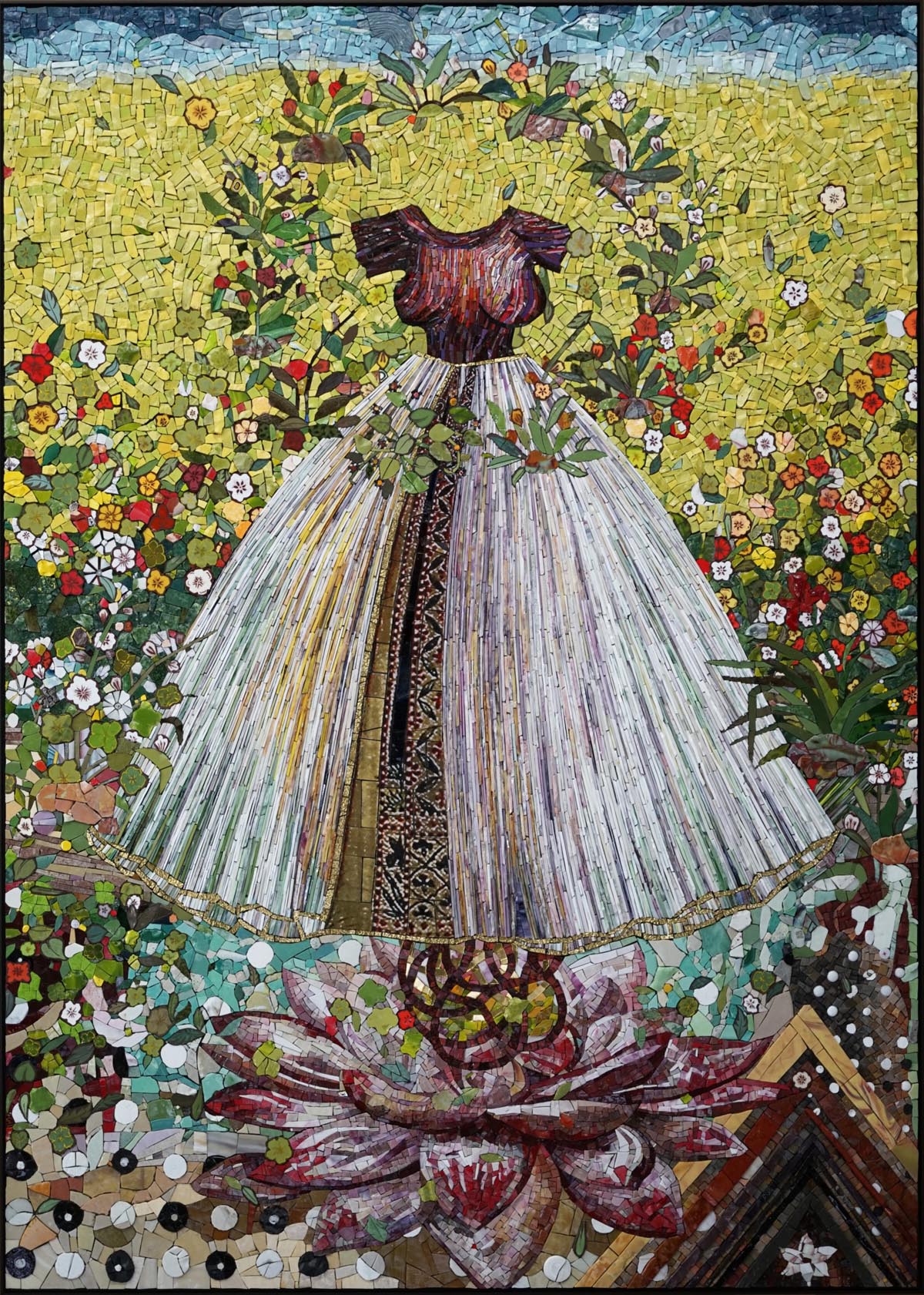
Shahzia Sikander (Pakistani and American, b. 1969), Fixed, Fluid, 2022, glass mosaic with patinated brass frame, Dr. Fatima Zuberi
83 1/8 x 59 7/8 in. (211.1 x 152.1 cm)
Description
Hi, I’m Jill Cleary, the museum’s visitor research coordinator. I am reading the description of Fixed, Fluid in Shahzia Sikander: Collective Behavior.
Fixed, Fluid, from 2022, is a glass mosaic with a patinated brass frame. It is by Shahzia Sikander, a Pakistani and American artist born in 1969. It is in the collection of Dr. Fatima Zuberi.
Fixed, Fluid is a vertically oriented glass mosaic with a patinated frame. A large work, it measures 83 and one-eighth by 59 and seven-eighths inches or 211.1 by 152.1 centimeters. A headless and armless female figure hovers above a pink and purple lotus blossom in a floral landscape. Moving from the top to bottom, a sliver of blue sky is evident above a large expanse of yellow ground extending to the mosaic's midpoint. Floral forms of red, white, yellow, and green encompass the scene from the work's center to the base. Surrounding the figure’s torso is a wreath of foliage and flowers that extends past the waist of the skirt. . Bright blue emits from the bottom of the skirt, surrounding the top of the lotus blossom. To the right of the flower, triangles layered with various shades of brown jut out from the bottom of the composition. Returning to the female form, she wears a skin-tight, burgundy blouse. From the waist to the feet, the figure wears a full, mainly white skirt with a textile belted at the waist and flowing down the front of the skirt. The textile is gold floral embroidery on dark blue with a gold hem.
Label
Hi, I’m Jill Cleary, the museum’s visitor research coordinator. I am reading the label for Fixed, Fluid in Shahzia Sikander: Collective Behavior.
Fixed, Fluid, from 2022, is a glass mosaic with a patinated brass frame. It is by Shahzia Sikander, a Pakistani and American artist born in 1969. It is in the collection of Dr. Fatima Zuberi.
Fixed, Fluid brings together multiple motifs that reflect Sikander’s practice, including the autonomous female figure, lotus base, fragmented border, and abstracted natural forms. Since 2015, mosaics have become an essential medium for the artist. With its inherent fragmentation, mosaic serves her interest in disrupting historic assumptions and ideals. Having worked with the pixels of digital animation since the early 2000s, Sikander is interested in how fragmented pieces of visual information can become whole. The two mediums remain linked through her process: she begins each mosaic by creating a digital animation out of multiple drawings. She stops the animation when she finds a frame she likes, using that as the basis for the mosaic’s image. Sikander then works closely with a fabricator, Franz Mayer of Munich, on each mosaic to select the glass and determine its orientation, often placing the glass pieces on their side and upside down—a material prompt to look at ideas from many angles.
Infinite Woman Artwork
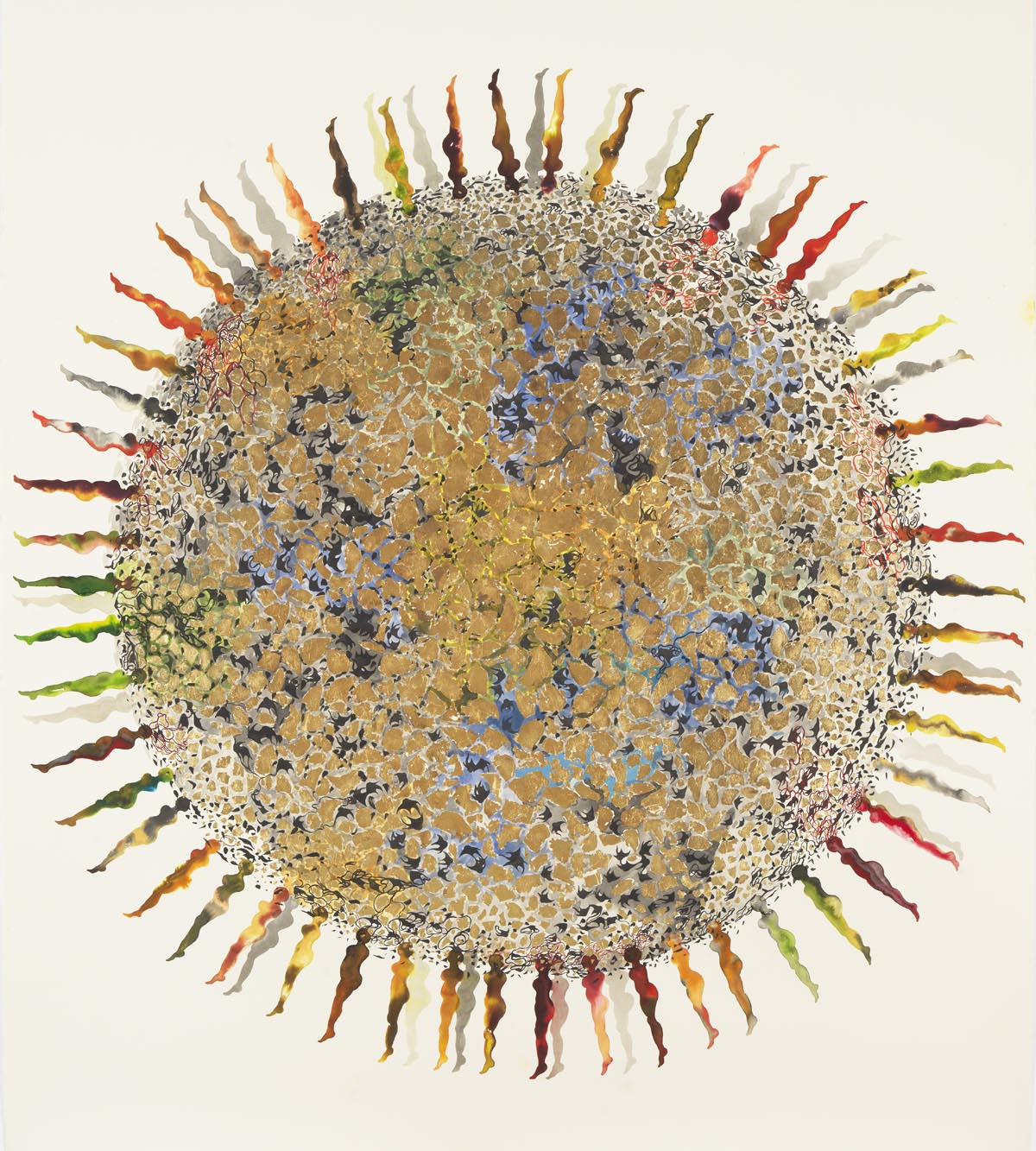
Shahzia Sikander (Pakistani and American, b. 1969), Infinite Woman, 2019–2021, watercolor, ink, gouache, and gold leaf on paper, Shah Garg Collection
69 1/4 x 60 1/4 in. (175.9 x 153 cm)
Description
Hi, I’m Jill Cleary, the museum’s visitor research coordinator. I am reading the description of Infinite Woman in Shahzia Sikander: Collective Behavior.
Shahzia Sikander, a Pakistani and American artist born in 1969, painted Infinite Woman between 2019 and 2021. It is watercolor, ink, gouache, and gold leaf on paper. The work is in the Shah Garg Collection.
Infinite Woman is watercolor, ink, gouache, and gold leaf on paper. Considerable in size and almost square in appearance, it measures 69 and one-quarter by 60 and one-quarter inches or 175.9 x 153 centimeters. An immense blue, gold, green, and gray orb, resembling the earth, is the focal point of this painting. Evenly arrayed around this globe, as if protruding from it, are 52 female torsos and legs viewed from profile. Black and gray depictions of gopis’ hair (isolated forms of hair from historic depictions of gopis, the cowherds and devotees of Krishna) are interspersed throughout the colored orb, growing denser at the edges of the sphere. Each form is a distinct color, ranging from brown to red to green and gray. This entire scene is on a cream-colored background.
Label
Hi, I’m Jill Cleary, the museum’s visitor research coordinator. I am reading the label for Infinite Woman in Shahzia Sikander: Collective Behavior.
Shahzia Sikander, a Pakistani and American artist born in 1969, painted Infinite Woman between 2019 and 2021. It is watercolor, ink, gouache, and gold leaf on paper. The work is in the Shah Garg Collection.
This large-scale drawing uses both minute detail and monumentality to convey the immeasurable capability of women. At first, the central image resembles a parched earth or satellite image. On closer inspection, however, the sphere is delicately formed by isolated gopis’ hair and gold leaf, centering feminine presence once again. Sikander asks: “Do women move the earth? Do they control the earth? Does their labor move the earth? I see universal movement inherent in women, through their fertility, fecundity, their essence of being. Women share stories, memories pass through them over generations. They are infiniteness.”
Through the repetition of the standing female form shown in profile, a collective swarm of the gopis’ hair, and the imagery of a globe, Sikander demonstrates that feminine power exists beyond categorization, political-social structures, or restrictions. Yet these feminine forms are sharp—they resemble spikes. Such power and presence is uncomfortable and painful to hold.
Cholee Kay Peechay Kiya? Chunree Kay Neechay Kiya? (What is under the Blouse? What is under the Dress?) Artwork
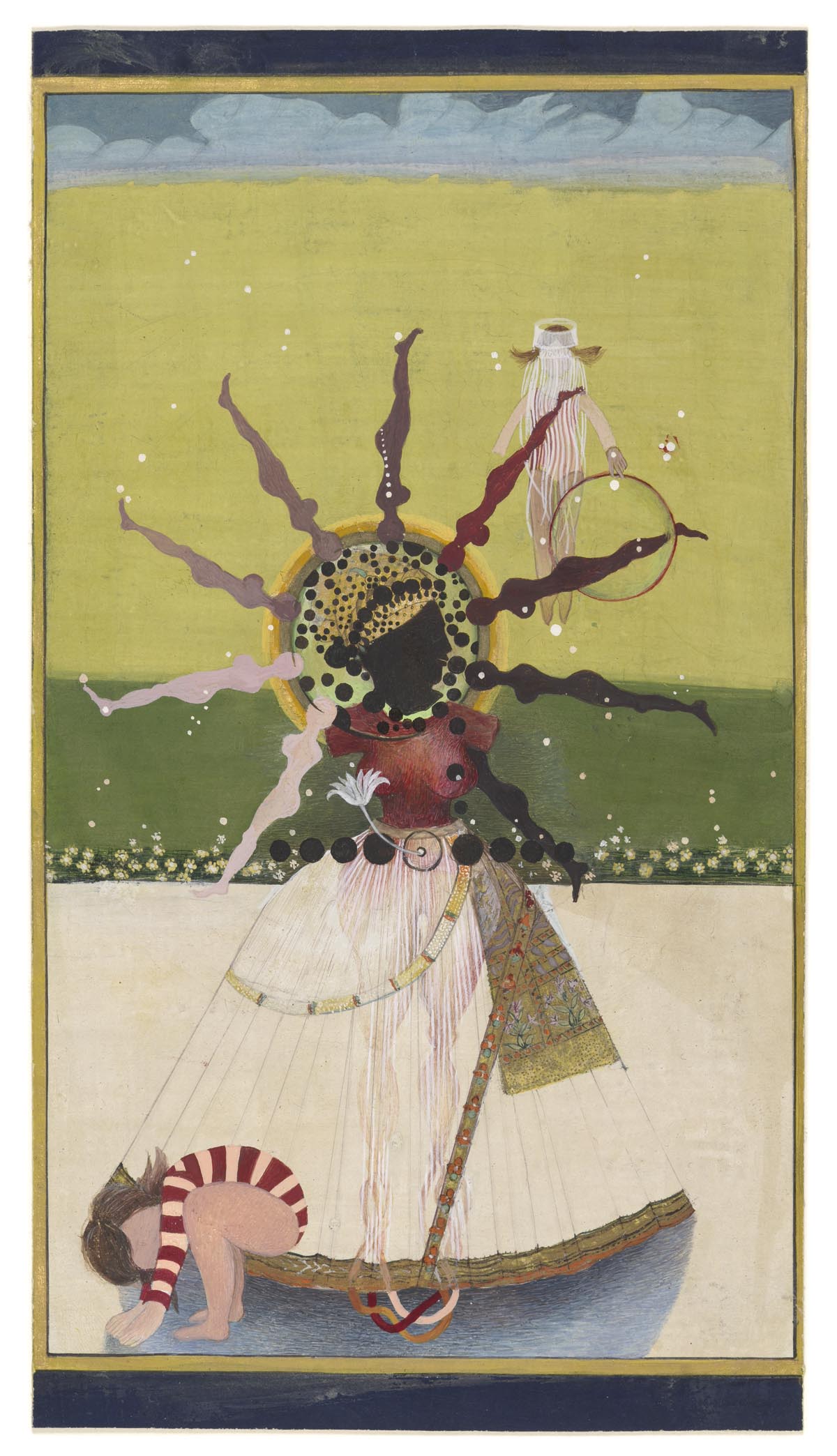
Shahzia Sikander (Pakistani and American, b. 1969), Cholee Kay Peechay Kiya? Chunree Kay Neechay Kiya? (What is under the Blouse? What is under the Dress?), 1997, vegetable color, dry pigment, watercolor, and tea on wasli paper; Hessel Museum of Art, Marieluise Hessel Collection, Hessel Museum of Art, Center for Curatorial Studies, Bard College, Annandale-on-Hudson, New York, R1999.49
9 1/4 x 5 1/8 in. (23.5 x 13 cm)
Description
Hi, I’m Anu Mitra, a museum board member and docent. I am reading the description of Cholee Kay Peechay Kiya? Chunree Kay Neechay Kiya? (What is under the Blouse? What is under the Dress?) in Shahzia Sikander: Collective Behavior.
Cholee Kay Peechay Kiya? Chunree Kay Neechay Kiya? (What is under the Blouse? What is under the Dress?) from 1997 is vegetable color, dry pigment, watercolor, and tea on wasli paper. It is by Shahzia Sikander, a Pakistani and American artist born in 1969. It is in the collection of the Hessel Museum of Art, Marieluise Hessel Collection, Center for Curatorial Studies, Bard College, Annandale-on-Hudson, New York. The museum registration number is R1999.49.
Cholee Kay Peechay Kiya? Chunree Kay Neechay Kiya? (What is under the Blouse? What is under the Dress?) is a vertically oriented vegetable color, dry pigment, watercolor, and tea on wasli paper painting. It measures nine and one-quarter by five and one-eighths inches or 23.5 by 13 centimeters. A headless and armless female figure stands centrally in an outside space. She wears a burgundy, skintight blouse, a full semi-translucent white skirt hangs from the waist to the feet with an embroidered gold hem, and a gold floral embroidered waist sash. Two belt-like straps cross the skirt, one of which is made of pearls. The stem of a white lotus flower emits from the figure’s navel. The outline of the figure’s form, complete with tentacle-like feet, is evident through the skirt. Across the waist of the skirt and extending to each side are nine circles, the central transparent and the others black. The black silhouette of a head facing right with gold turban hovers above the headless form. It appears in a halo-like circle, with additional black dots of assorted sizes overlaying the head. Emerging from this halo, nine female torsos and legs in various flesh tones surround the head of the figure.
Behind the central figure is a flattened landscape of a dark blue sky with clouds at the very top of the composition; next, an expanse of yellow-green fills the upper half of the work, then a broad band of green edged with white flowers, and finally, a sand-colored space upon which the figure stands. Behind her haloed head and to the right, a young girl in a tan body suit wearing a veiled head piece holds a red hoop. In the lower-left corner of the work, another girl wearing a red and white striped long-sleeved body suit bends over, reaching toward the frame of the composition.
Label
Hi, I’m Anu Mitra, a museum board member and docent. I am reading the label for Cholee Kay Peechay Kiya? Chunree Kay Neechay Kiya? (What is under the Blouse? What is under the Dress?) in Shahzia Sikander: Collective Behavior.
Cholee Kay Peechay Kiya? Chunree Kay Neechay Kiya? (What is under the Blouse? What is under the Dress?) from 1997 is vegetable color, dry pigment, watercolor, and tea on wasli paper. It is by Shahzia Sikander, a Pakistani and American artist born in 1969. It is in the collection of the Hessel Museum of Art, Marieluise Hessel Collection, Center for Curatorial Studies, Bard College, Annandale-on-Hudson, New York. The registration number is R1999.49.
This work’s title comes from a song in the popular 1993 Bollywood film Khalnayak (The Villain). In the scene where the song plays, two women sensuously dance together while a man observes them. In Sikander’s response to the scene, she portrays a solitary feminine figure in male dress. The turban, skirt, patka (belt or sash), and compositional format reference Mughal court fashion and painting of the seventeenth century. The fluid figure contains a multiplicity of meaning; in Hindu religious thought, the creation of the universe emanated from a lotus that sprouted from the god Brahma’s navel.
Seen as a whole, Sikander’s figure moves beyond history, religion, and binary definitions of gender to consciously and playfully queer convention. In reference to the feminine presence in her work, Sikander said: “The women in my work are always complex, proactive, confident, and intelligent and in their playful stances they are connected to the past in imaginative ways without being tied to a heteronormative lineage or conventional representations of diaspora and nation.”
Housed Artwork
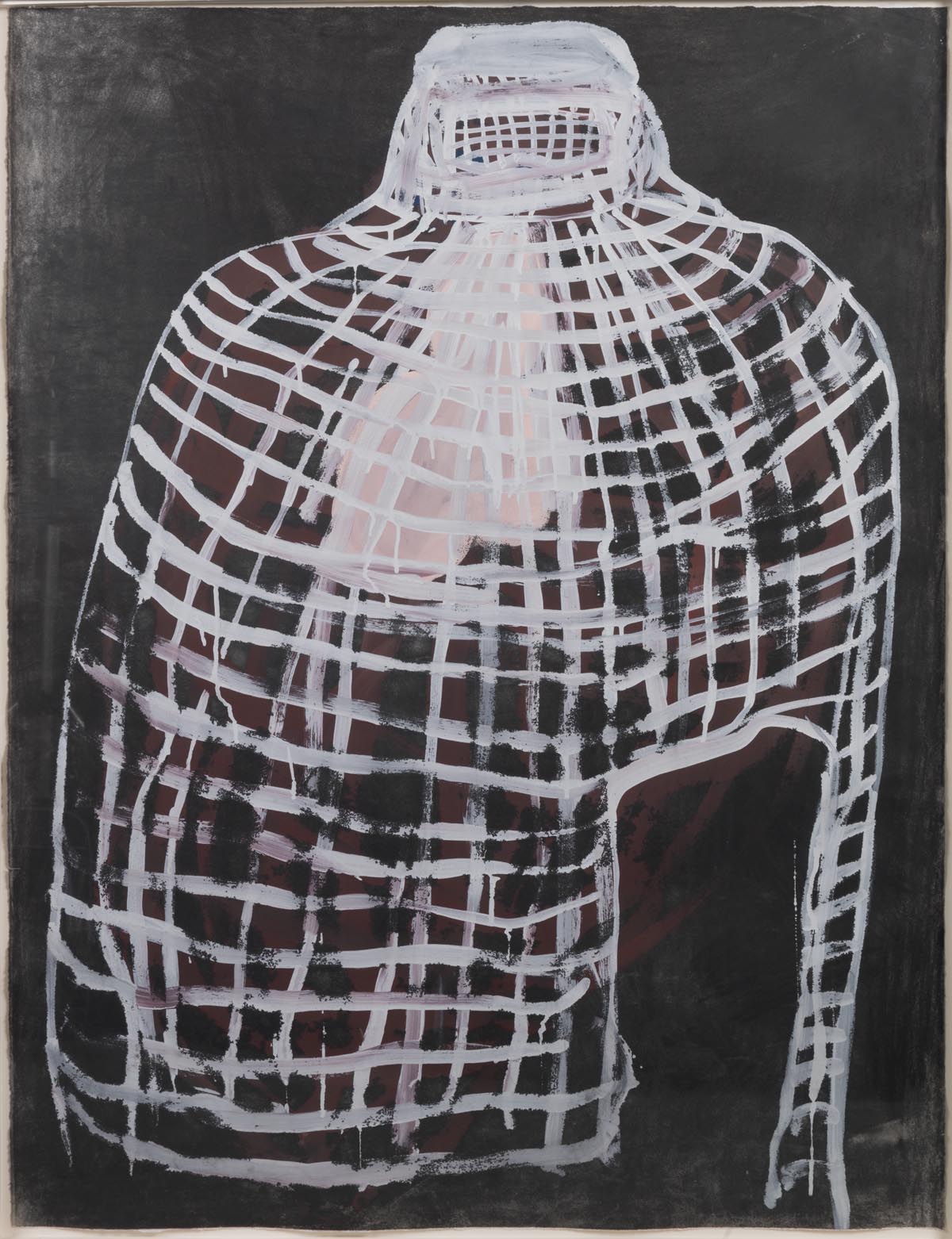
Shahzia Sikander (Pakistani and American, b. 1969), Housed, 1995, gouache and charcoal on clay-coated paper board, Courtesy of Sean Kelly, New York/Los Angeles
42 1/8 X 31 5/8 X 1 3/8. in. (107 x 80.3 x 3.5 cm)
Description
Hi, I’m Eric Hughett, the museum’s curatorial assistant for East Asian Art. I am reading the description of Housed in Shahzia Sikander: Collective Behavior.
Housed, from 1995, is gouache and charcoal on clay-coated paper board. It was created by Shahzia Sikander, a Pakistani and American artist born in 1969. It is in the exhibition courtesy of Sean Kelly, New York and Los Angeles.
Housed is a vertically oriented mixed media work comprised of gouache and charcoal on a clay-coated paper board. It measures 42 and one-eighth by 31 and five-eighths by one and three-eighths inches or 107 by 80.3 by 3.5 centimeters. An elongated domed birdcage-like form occupies the entirety of this composition. Placed on a mottled black and brown background, the grid of the cage’s bars is white, and the line work is uneven, varying in thickness and spacing. In the lower left is a large rectangular opening, without a door. Hanging upside down inside the cage is a light pink heart barely visible through the grid.
Label
Hi, I’m Eric Hughett, the museum’s curatorial assistant for East Asian Art. I am reading the label for Housed in Shahzia Sikander: Collective Behavior.
Housed, from 1995, is gouache and charcoal on clay-coated paper board. It was created by Shahzia Sikander, a Pakistani and American artist born in 1969. It is in the exhibition courtesy of Sean Kelly, New York and Los Angeles.
The gestural movement of Sikander’s brush creates an abstracted form that is part architectural, part figural. The upper portion, a face covering for a shuttlecock burka, is most clearly articulated. Referring to the burka, Sikander said: “For me, art is about knowledge construction: how we reckon with our otherness in a shifting world, how we approximate, reproduce, and reenact our history. Housed is a haunted image that responds to the Orientalist obsession with the veil in the Western imagination. Is it armor, mask, or shelter? The cage-like form has a door, and a pink heart inside. This tapped into my anxiety of being boxed into a stereotype of a culture or religion.”
Liquid Light II Artwork
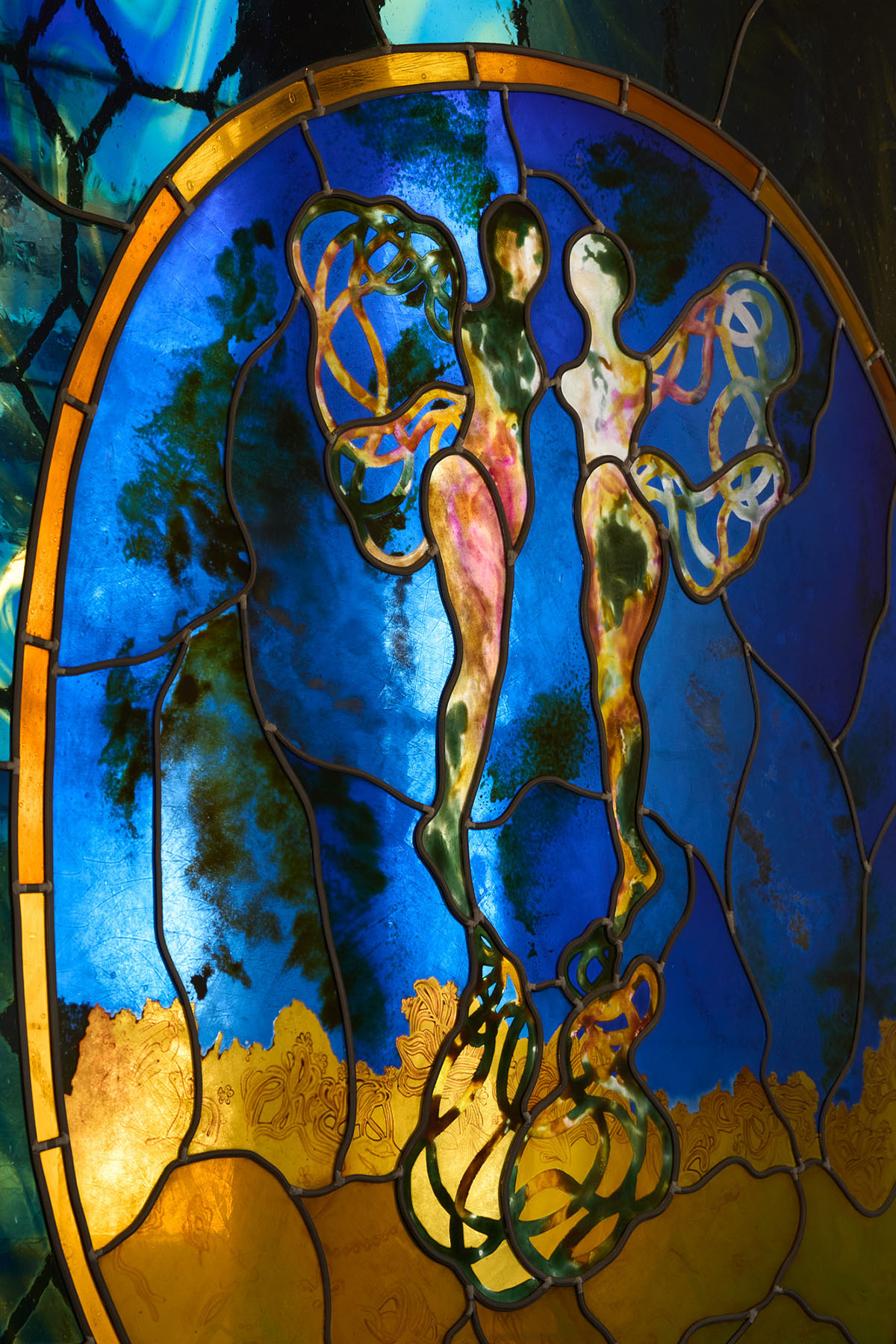
Shahzia Sikander (Pakistani and American, b. 1969), Liquid Light II, 2024, painted, etched, and laminated glass, Courtesy of Sean Kelly, New York/Los Angeles
65 3/8 x 43 1/4 x 5/8 in. (166.1 x 109.9 x 1.6 cm)
Description
Hi, I’m Eric Hughett, the museum’s curatorial assistant for East Asian Art. I am reading the description of Liquid Light II in Shahzia Sikander: Collective Behavior.
Shahzia Sikander, a Pakistani and American artist born in 1969, created Liquid Light II in 2024. It is painted, etched, and laminated glass. It is in the exhibition courtesy of Sean Kelly, New York and Los Angeles.
Liquid Light II is a sizeable painted, etched, and laminated glass artwork. Vertically oriented, it measures 65 and three-eighths by 43 and one-quarter by five-eighths inches or 166.1 by 109.9 by 1.6 centimeters. In this stained-glass work, the artist creates an oval composition inside a marbled cobalt blue and light-yellow rectangular space--thus creating a frame. The scene inside the oval, bordered by a thin band of gold, is of two winged female forms hovering in a blue space. The figures are made up of patterns in shades of white, green and deep pink and shown in profile facing each other. Wavy tentacle-like shapes decorate each of their translucent wings. These wavy lines repeat at the foot of each figure as if sprouting out of their toes, connecting the two figures as the tendrils overlap each other. Along the base of the work is a gold expanse representing the ground. A red lotus blossom is in the center, at the bottom of the oval.
Label
Hi, I’m Eric Hughett, the museum’s curatorial assistant for East Asian Art. I am reading the label for Liquid Light II in Shahzia Sikander: Collective Behavior.
Shahzia Sikander, a Pakistani and American artist born in 1969, created Liquid Light II in 2024. It is painted, etched, and laminated glass. It is in the exhibition courtesy of Sean Kelly, New York and Los Angeles.
Sikander considers light to be a medium that she works with—whether it is the use of light within a composition, or here, where light streams through the painted glass activating the artwork. She seeks to understand how light tracks through the different layers of paint; when installed with natural light behind, as it was in Venice, it changes how the painting reveals itself throughout the day.
Created for the Venice presentation of Collective Behavior, Liquid Light I (at this exhibition’s entrance) and Liquid Light II activate a medium long associated with Venice. Sikander’s use and manipulation of the form merge global trade histories with South Asian imagery. Sikander, referring to her practice, said: “I leave the possibilities open to allow ideas to fall into place, sometimes through dreams and reflection, but always through experimentation with physical materials.”
Exhibition Section: Negotiated Landscapes and Contested Histories
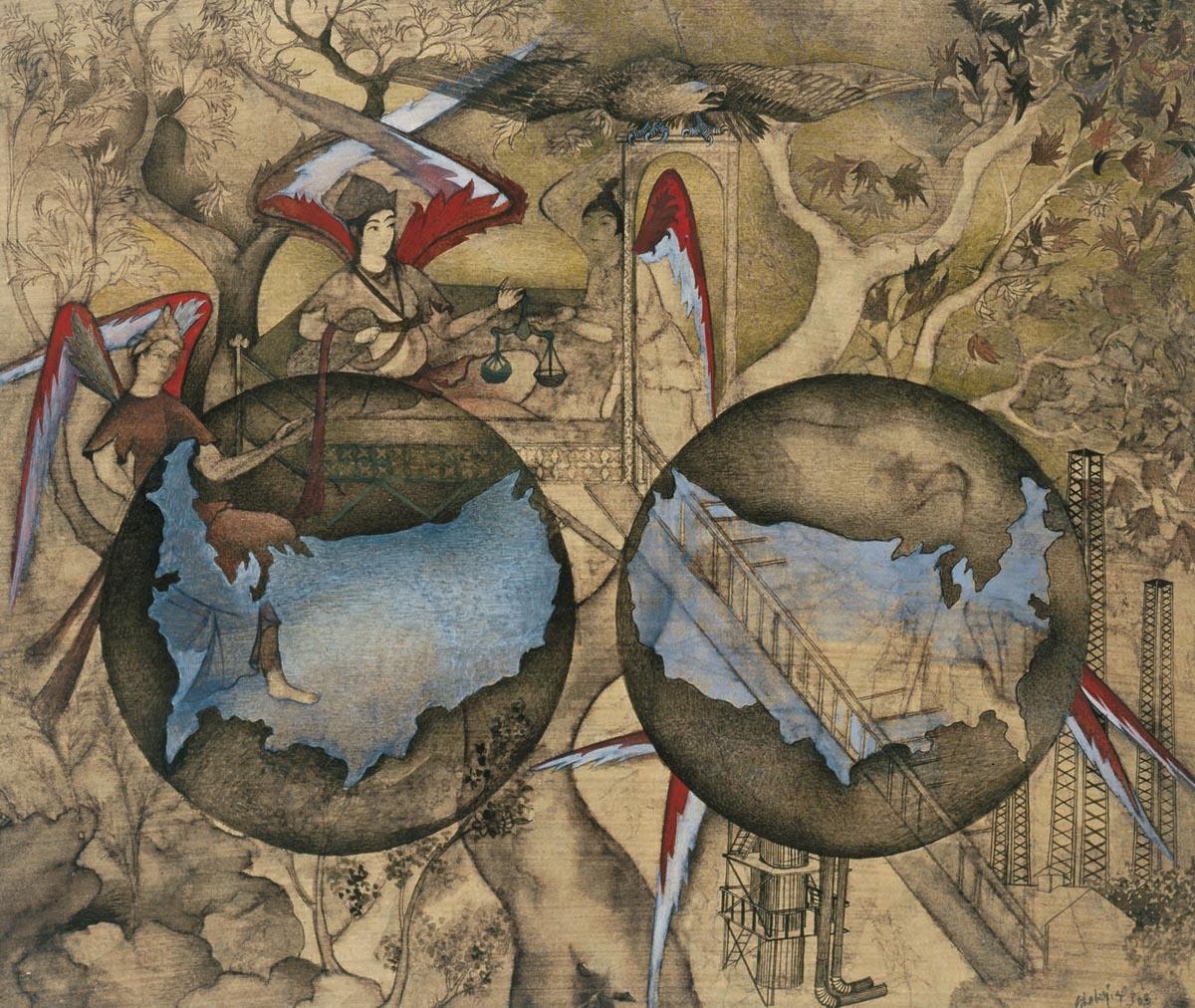
Shahzia Sikander (Pakistani and American, b. 1969), United World Corp, 2003, watercolor, dry pigment, and inkjet on wasli paper; The Speyer Family Collection, New York
Description
Hi, I’m Ainsley Cameron, the museum’s curator of South Asian Art, Islamic Art, and Antiquities and the curator of Shahzia Sikander: Collective Behavior. I am reading the “Negotiated Landscapes and Contested Histories” section label.
The works in this section consider the complex histories of colonialism in South Asia and their legacies in language, trade, empire, and the migration patterns of today. Over 300 years of rule, the East India Company (1600–1874) and later the British Raj (1858–1947) divided political power and cultural authority, fracturing the subcontinent’s interwoven histories. Eventually, in 1947, colonial powers carved a vast geographic terrain into two modern countries, India and Pakistan (and later Bangladesh in 1971), based on each region’s respective Hindu and Muslim religious majorities. Following Independence, the conflicts of Partition gave way to the fraught transition to new nationhood.
In her work, Sikander responds to this history, which continues to fracture land and people. Through globe and map motifs, she explores how geography and nationality are formally characterized. The recurring image of an oil rig stands for the global economic and ecological consequences of that industry. And, the image of a flying peri, the mythical being or angel from historic Islamic manuscripts, plays with the ambiguity of “right” and “wrong” in global politics. As Sikander reframes symbols and iconographies, she invites us to reimagine established interpretations of an inherited past.
The Many Faces of Islam Artwork
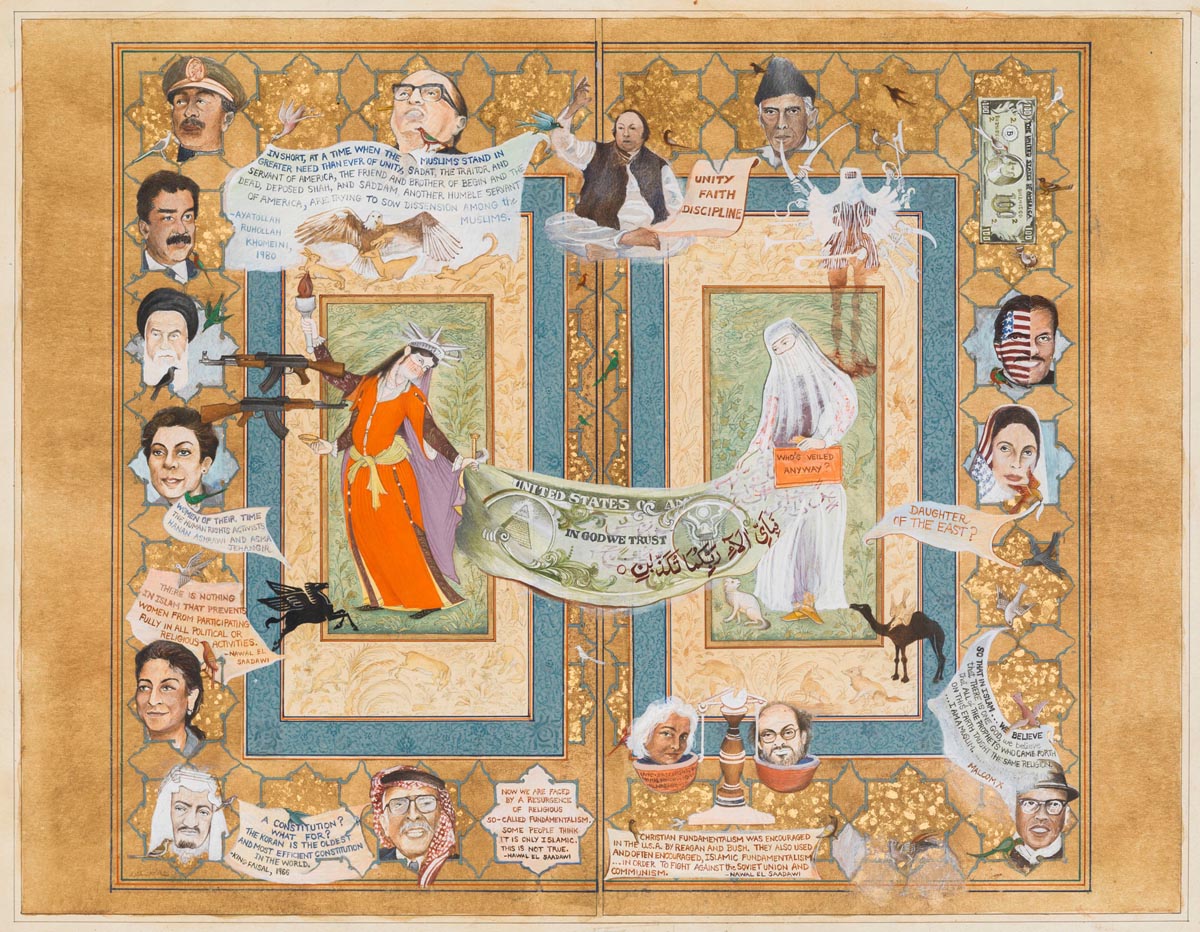
Shahzia Sikander (Pakistani and American, b. 1969), The Many Faces of Islam, 1999, gouache, vegetable color, watercolor, gold leaf, graphite, and tea on wasli paper; Collection of the Artist, Courtesy of Shahzia Sikander and Sean Kelly, New York/Los Angeles
Description
Hi, I’m Rose Milnes, the museum’s Curatorial Assistant for South Asian Art, Islamic Art, and Antiquities. I am reading the description of The Many Faces of Islam in Shahzia Sikander: Collective Behavior.
The Many Faces of Islam, from 1999, is gouache, vegetable color, watercolor, gold leaf, graphite, and tea on wasli paper. It is by Shahzia Sikander, a Pakistani and American artist born in 1969. It is in the artist’s collection and in the exhibition courtesy of Shahzia Sikander and Sean Kelly, New York and Los Angeles.
The Many Faces of Islam is a small, gouache, vegetable color, watercolor, gold leaf, graphite, and tea on wasli paper artwork. It measures 17 by 12 inches or 43.2 by 30.5 centimeters. Here, the artist used the form of an illustrated manuscript to create her composition—three decorative borders frame two central, vertical scenes. Moving from the outside, the first is a broad, faded gold frame decorated with a series of 15-sided geometric shapes outlined in gray. The next border is light blue with a darker blue floral decoration. The final border is tan with gold decorations depicting flowers and animals. The female figure on the left is in a green outdoor space. She has three arms, two on her right and one on her left, and appears from the front, slightly leaning to the left. She wears a long, red, loose gown belted with a gold sash, and a half-veil covering her nose and mouth. On top of her long dark hair is a crown that resembles that worn by the Statue of Liberty. Her two right hands hold a torch raised about her head and bun-like shape. Her left hand holds onto a banner, held on the other side by the figure on the right. The banner is the back of the U.S. dollar bill with Urdu calligraphy written in dark red.
The female figure on the right is also in a green outdoor space. She wears a long white semi-transparent burqa, her dark purple clothing apparent underneath. She holds an orange sign that says, “Who’s Veiled Anyway?” At her feet is a small white dog. To the right of the figure, a veiled, tendrilled, floating form with fourteen arms carries various objects and weapons in each hand.
Superimposed around these central images, on the wide gold border, are portraits of 12 historic figures. Moving clockwise from the top left, they are Anwar Sadat, Menachem Begin, Nusrat Fateh Ali Khan, Muhammad Ali Jinnah, Muhammad Zia-ul-Haq, Benazir Bhutto, Malcolm X, Salman Rushdie, Nawal el Saadawi, King Hussein bin Talal, King Faisal bin Abdulaziz Al Saud, Asma Jahangir, Hanan Ashrawi, Ayatollah Ruhollah Khomeini, and Saddam Hussein. Also arranged on this border are banners containing quotes by several figures represented, along with images of American money, eagles, automatic weapons, birds, a winged horse, and other animals.
Label
Hi, I’m Rose Milnes, the museum’s Curatorial Assistant for South Asian Art, Islamic Art, and Antiquities. I am reading the label for The Many Faces of Islam in Shahzia Sikander: Collective Behavior.
The Many Faces of Islam, from 1999, is gouache, vegetable color, watercolor, gold leaf, graphite, and tea on wasli paper. It is by Shahzia Sikander, a Pakistani and American artist born in 1969. It is in the artist’s collection and in the exhibition courtesy of Shahzia Sikander and Sean Kelly, New York and Los Angeles.
Sikander created this painting for The New York Times Magazine feature “Old Eyes and the New: Scenes from the Millennium, Reimagined by Living Artists” published in the September 1999 issue. The two central figures hold between them a piece of American currency inscribed with a quote from the Qur’an: “Which, then, of your Lord’s blessing do you both deny?” The surrounding figures speak to the shifting global alliances between Muslim leaders, the American empire, and capitalism. Referencing the inspiration for this work, Sikander said: “The 1990s was about war, coalitions, alternating friends and foes, imposed sanctions, debts forgiven, and human rights brushed under the carpet as America flexed its military muscle around the world. This work took this history into account, and I proposed that American policy in Islamic countries would become a defining issue in the new millennium.”
Self-Mirage Artwork
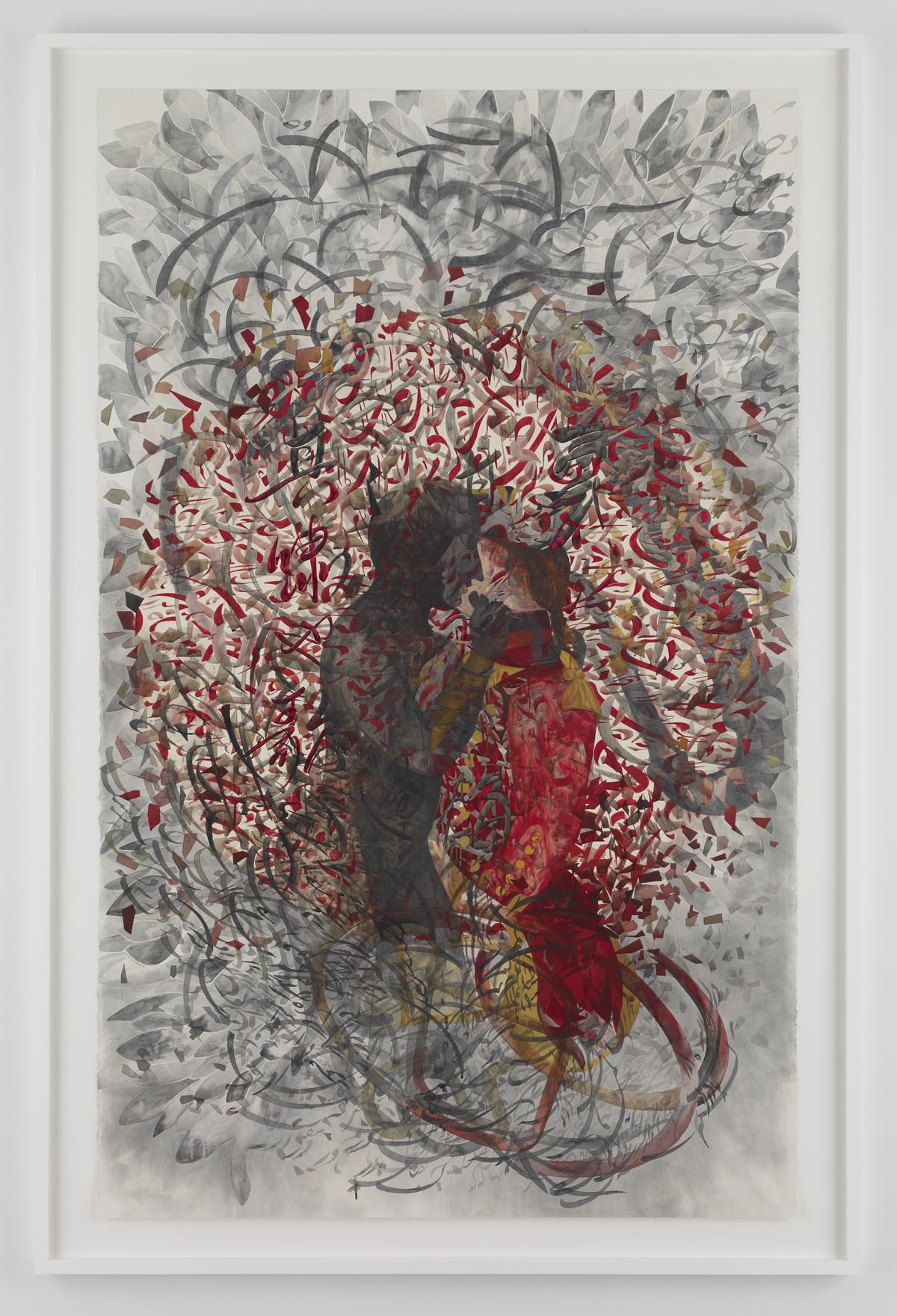
Shahzia Sikander (Pakistani and American, b. 1969), Self-Mirage, 2011, ink and gouache on paper; Courtesy of Sean Kelly, New York/Los Angeles
81 7/8 x 51 in. (208 x 129.5 cm)
Description
Hi, I’m Sara Vance Waddell, an art collector and museum supporter. I am reading the description of Self-Mirage in Shahzia Sikander: Collective Behavior.
Shahzia Sikander, a Pakistani and American artist born in 1969, created Self-Mirage in 2011. It is ink and gouache on paper. It is in the exhibition courtesy of Sean Kelly, New York and Los Angeles.
Self-Mirage is a large, vertically oriented ink and gouache on paper painting. It measures 81 and seven-eighths by 51 inches or 208 by 129.5 centimeters. A male figure is portrayed in profile, resembling a silhouette or shadow. He embraces, as if about to kiss, another male figure, who is white and dressed in the red frock coat of an eighteenth century British military uniform. Both of their forms end just past the waist. Behind the British soldier floats a shadowy silhouette of a tuba. Red, burgundy, gold, gray, and black marks that resemble calligraphic script swirl around these figures, absorbing them into the background. These marks, specifically those in red and gold, are more concentrated around the forms and fade to grays and blacks toward the edges of the work.
Label
Hi, I’m Sara Vance Waddell, an art collector and museum supporter. I am reading the label for Self-Mirage in Shahzia Sikander: Collective Behavior.
Shahzia Sikander, a Pakistani and American artist born in 1969, created Self-Mirage in 2011. It is ink and gouache on paper. It is in the exhibition courtesy of Sean Kelly, New York and Los Angeles.
Self-Mirage reflects Sikander’s engagement with colonial histories through the manipulation and mirroring of the East India Company Man, a signature motif in the artist’s practice. Here, the Company Man faces nefarious colonial histories through his dark consciousness, portrayed as a shadowy figure with whom he shares an intimate embrace. Through their joined form, gestural calligraphic line, and swarming accumulation of line and image, Sikander refers to the entanglement of war, patriarchal structures, colonialism, and capitalism.
Started before but completed after the 2010 animation The Last Post, the two works share imagery, meaning, and pattern. In both, Sikander uses repetition to meld calligraphy and the musical score, illustrating how music imprints on memory and the body. Ideas born through text, writing, and gesture fragment, disintegrate, and reassemble.
Promiscuous Intimacies Artwork
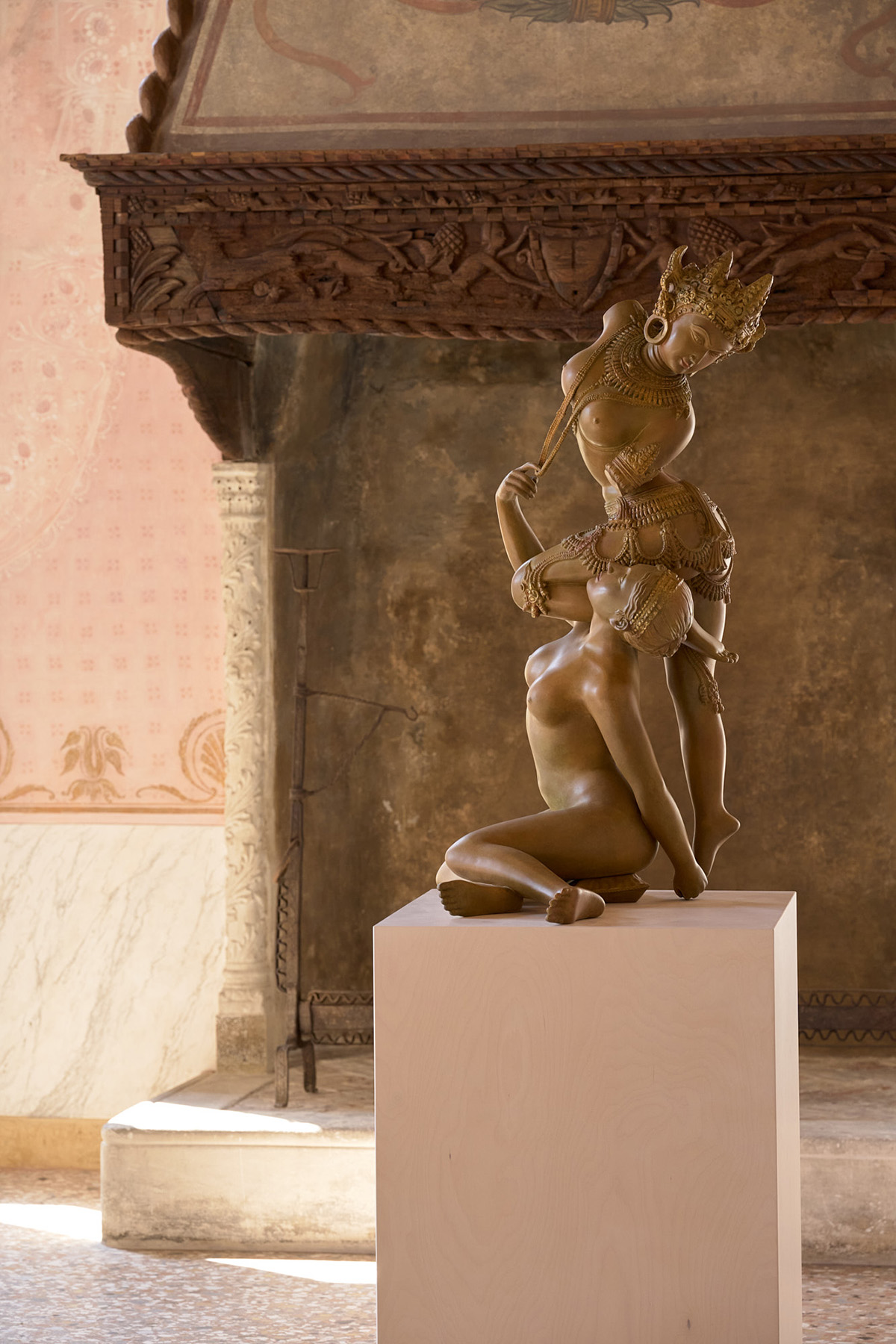
Shahzia Sikander (Pakistani and American, b. 1969), Promiscuous Intimacies, 2020, patinated bronze, Courtesy of Joel S. Pizzuti
42 x 24 x 18 in. (106.7 x 61 x 45.7 cm), 150 lbs.
Description
Hi, I’m Sara Vance Waddell, an art collector and museum supporter. I am reading the description of Promiscuous Intimacies in Shahzia Sikander: Collective Behavior.
Promiscuous Intimacies, from 2020, is patinated bronze. It was created by Shahzia Sikander, a Pakistani and American artist born in 1969. It is in the exhibition courtesy of Joel S. Pizzuti.
A three-dimensional patinated bronze sculpture, Promiscuous Intimacies measures 42 by 24 by 18 inches or 106.7 by 61 by 45.7 centimeters. It weighs 150 pounds. A young, nude female figure sits on a small pillow, both legs bent to her left side. Her left arm stretches behind her, and she holds the toes of the figure standing to her right. She raises her right arm and hooks her pointer finger in the long necklace of her companion. Her hair is pulled back in a bun at the nape of her neck, and a diadem, lying flat to her head and decorated with jewels and a center stone, extends from ear to ear. She raises her head to look at the figure. The second figure, also female, balances on her right tiptoe; her left leg bends at the knee and rests on the sitting figure’s right shoulder. She twists her body to look over her left shoulder and down at her companion. She does not have lower arms. The standing figure wears an ornate, pointed crown with several cone-like projections and floral designs. Her hair extends from the back of her head and wraps around her waist. Large, hooped earrings hang from her ears. Around her neck, upper arms, waist, and hips are layers upon layers of intricately detailed designs representing jewelry.
Label
Hi, I’m Sara Vance Waddell, an art collector and museum supporter. I am reading the label for Promiscuous Intimacies in Shahzia Sikander: Collective Behavior.
Promiscuous Intimacies, from 2020, is patinated bronze. It was created by Shahzia Sikander, a Pakistani and American artist born in 1969. It is in the exhibition courtesy of Joel S. Pizzuti.
Promiscuous Intimacies depicts a flirtatious encounter between the Roman goddess Venus and a Hindu celestial dancer. Playing with traditional power hierarchies, Sikander represents Venus, a symbol of European culture, gazing upwards at an icon of South Asian heritage. She based the two figures on, respectively, Agnolo Bronzino’s An Allegory with Venus and Cupid (circa 1545) and an eleventh-century temple sculpture fragment from Madhya Pradesh, India.
Sikander first created this composition as part of a drawing from 2001. When she enlarged the drawn image for the sculpture—her first foray into this medium—she had live models assume poses which she rendered in clay and cast in bronze.
Shroud Artwork
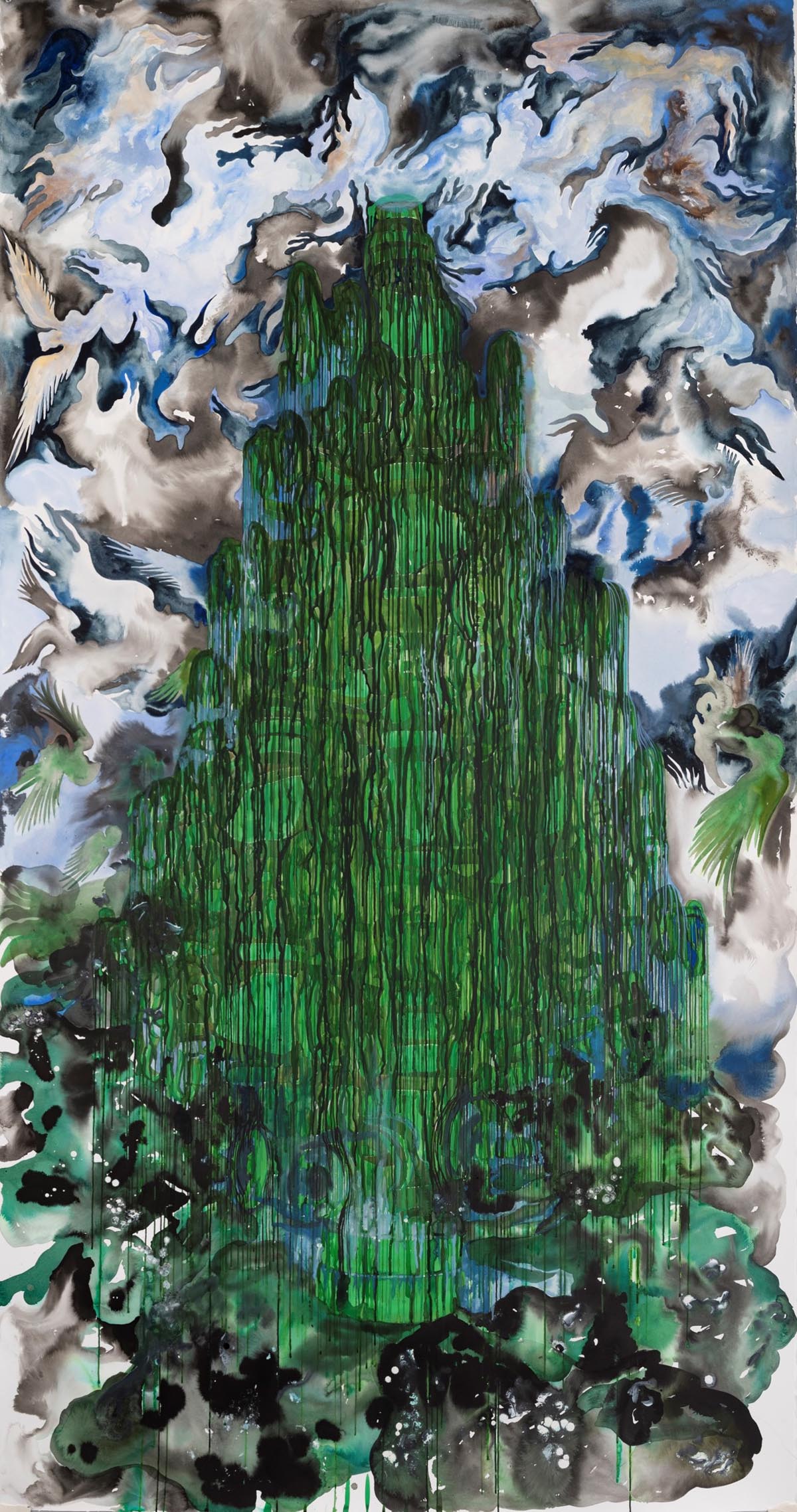
Shahzia Sikander (Pakistani and American, b. 1969), Shroud, 2020, watercolor, ink, and gouache on paper; Nicoletta Fiorucci Collection
98 x 51 in. (248.9 x 129.5 cm)
Description
Hi, I’m Zainab Zulfiqar, program manager of Twelve Gates Arts. I am reading the description of Shroud in Shahzia Sikander: Collective Behavior.
Shahzia Sikander, a Pakistani and American artist born in 1969, created Shroud in 2020. The work is watercolor, ink, and gouache on paper. It is in the Nicoletta Fiorucci Collection.
A large vertically oriented watercolor, ink, and gouache on paper painting, Shroud measures 98 by 51 inches or 248.9 by 129.5 centimeters. A large, green, undecorated Christmas tree form composed from stacked oil rigs is the focal point of this work. The paint looks to be dripping down the tree's side and onto the work's base. Swirls of light and bright blue, gray, white, and black decorate the background, reminiscent of camouflage, marbled paper, or dense, swirling clouds. This background design includes winged figures that fly around the tree. Near the base of the tree, more green, blue, and gray amorphous shapes are present.
Label
Hi, I’m Zainab Zulfiqar, program manager of Twelve Gates Arts. I am reading the label for Shroud in Shahzia Sikander: Collective Behavior.
Shahzia Sikander, a Pakistani and American artist born in 1969, created Shroud in 2020. The work is watercolor, ink, and gouache on paper. It is in the Nicoletta Fiorucci Collection.
Shroud reflects Sikander’s engagement with colonial histories and current political ideologies. Here, one of her signature motifs, an oil rig playfully called a Christmas Tree used to extract oil across the Middle East, explores the industry’s harmful ecological and sociological practices. Large swaths of human civilization depend on the labor generated by this volatile trade, the extraction of which drains environmental resources while also displacing peoples and cultures. Surrounding the Christmas Tree, Sikander repeats a winged figure drawn from historic illustrated manuscripts, which is both concealed and revealed by a tumultuous sky. Sikander encountered a photograph of this type of oil rig in a British Petroleum (BP) magazine published in 1962. She elaborated the form into a series of twelve paintings, which is ongoing.
Segments of Desire Go Wandering Off Artwork
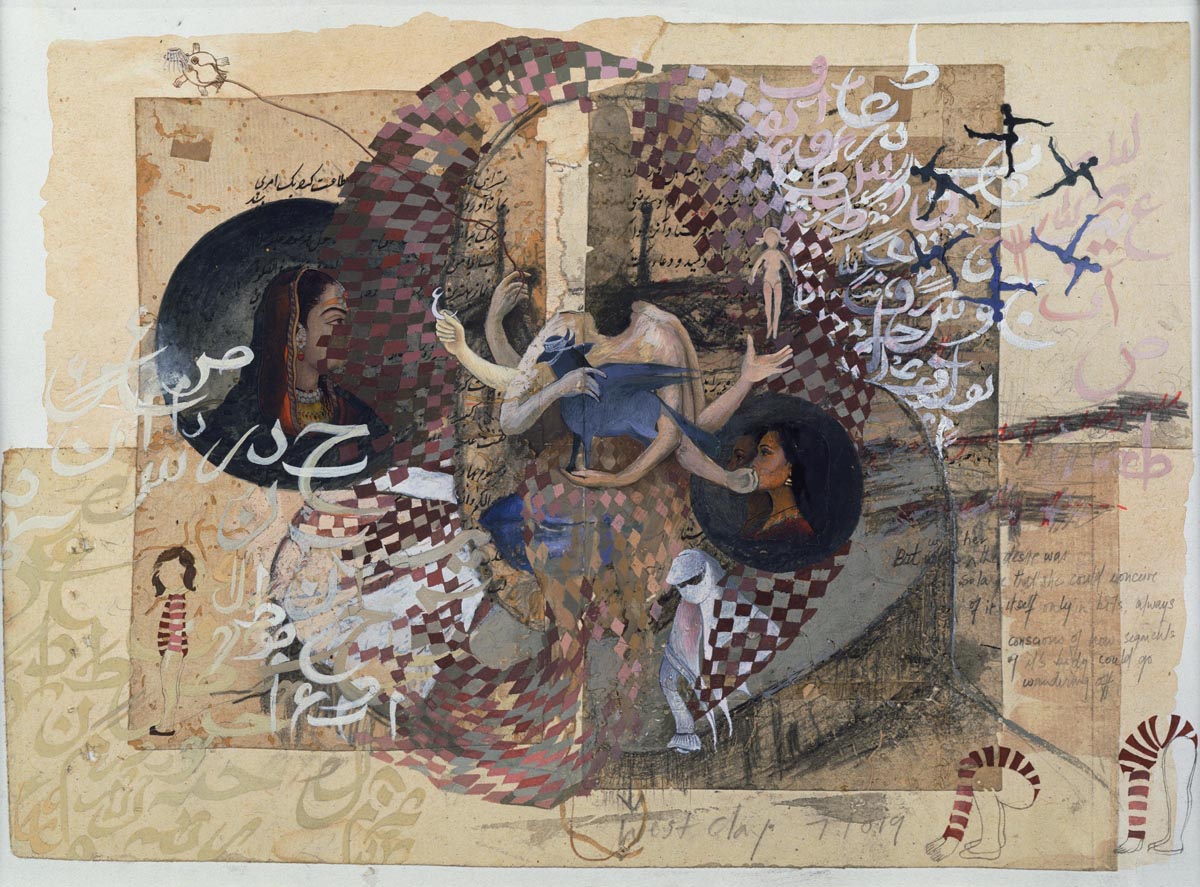
Shahzia Sikander (Pakistani and American, b. 1969), Segments of Desire Go Wandering Off, 1998, collage with vegetable color, dry pigment, watercolor, graphite, and tea on wasli paper, Martin and Rebecca Eisenberg
9 9/16 x 19 11/16 in. (24.3 x 50 cm)
Description
Hi, I’m Zainab Zulfiqar, program manager of Twelve Gates Arts. I am reading the description of Segments of Desire Go Wandering Off in Shahzia Sikander: Collective Behavior.
Segments of Desire Go Wandering Off from 1998 is a collage with vegetable color, dry pigment, watercolor, graphite, and tea on wasli paper. It is by Shahzia Sikander, a Pakistani and American artist born in 1969. It is in the collection of Martin and Rebecca Eisenberg.
A collage created using vegetable color, dry pigment, watercolor, graphite, and tea on wasli paper, Segments of Desire Go Wandering Off is a small, horizontally oriented work. It measures nine and nine-sixteenths by 19 and eleven-sixteenths inches or 24.3 by 50 centimeters. Placed on a beige background overlaid with white calligraphic script, a six-armed headless female figure sits at the center of this work. She raises her arms at different levels from her waist to above her head, each holding an item. In the upper right hand of the figure, a piece of string curls around a finger and extends beyond the frame of the painting, tethering a line drawing of a turtle to the figure’s hand. The middle right hand of the figure holds an Urdu letter, ein. The bottom two hands, both on the left and right, caress a winged griffin. On the figure’s left, the upper hand holds a hand under a hovering figure of a child. The middle hand extends toward a circular portrait of a South Asian woman.
To the figure’s right (viewer’s left) is a portrait of a veiled South Asian woman wearing gems and pearl jewelry posed in profile in a circular frame. To the central figure’s left (viewer’s right) and a bit lower is another portrait of a South Asian woman in profile and a circular frame. Her hair is uncovered, and she wears a modern dress and minimal jewelry. Both portraits face the central figure. Directly below the right picture is a woman in a white burqa. Encircling the central figure and superimposed over the left image and behind the right is a band of burgundy, mauve, gray, and black checkerboard design. In the lower-left corner is a drawing of a young girl in a red-striped bathing suit. In the upper right, a pinwheel of blue and black figures in a circle with arms and legs animated as if dancing. In the lower right words have been written in pencil. The passage reads: “But with her the desire was so large that could conceive of it itself only in bits, always conscious of how segments of its body could go wandering off.”
Label
Hi, I’m Zainab Zulfiqar, program manager of Twelve Gates Arts. I am reading the label for Segments of Desire Go Wandering Off in Shahzia Sikander: Collective Behavior.
Segments of Desire Go Wandering Off from 1998 is a collage with vegetable color, dry pigment, watercolor, graphite, and tea on wasli paper. It is by Shahzia Sikander, a Pakistani and American artist born in 1969. It is in the collection of Martin and Rebecca Eisenberg.
This painting layers imagery and text to explore the hyphenated identities many in the United States hold. At the center, a multiarmed, uprooted female tries to hold on to all she desires—a chalawa (symbolizing impermanence), a turtle (symbolizing endurance), a floating child, a portrait of a woman, and a self-portrait of the artist. Sikander painted the central figure over a large portrait of a trickster drawn by the Houston-based artist David McGee. She partly obscured all the faces, keeping racial and cultural identities shifting.
These emblems both reference and confront Sikander’s quiet discomfort with such overt signifiers of identity. The turtle flying off the page references the paradox of freedom on offer to immigrants in the U.S.—even if you want to reinvent yourself and be free, you are tethered to predetermined definitions. Regarding her experience in the United States, Shahzia said: “Inhabiting the feminine and Asian American—or Asian-anything—in the West often means living the paradox of being invisible while standing out.”
Exhibition Section: Collective Behavior at La Biennale di Venezia
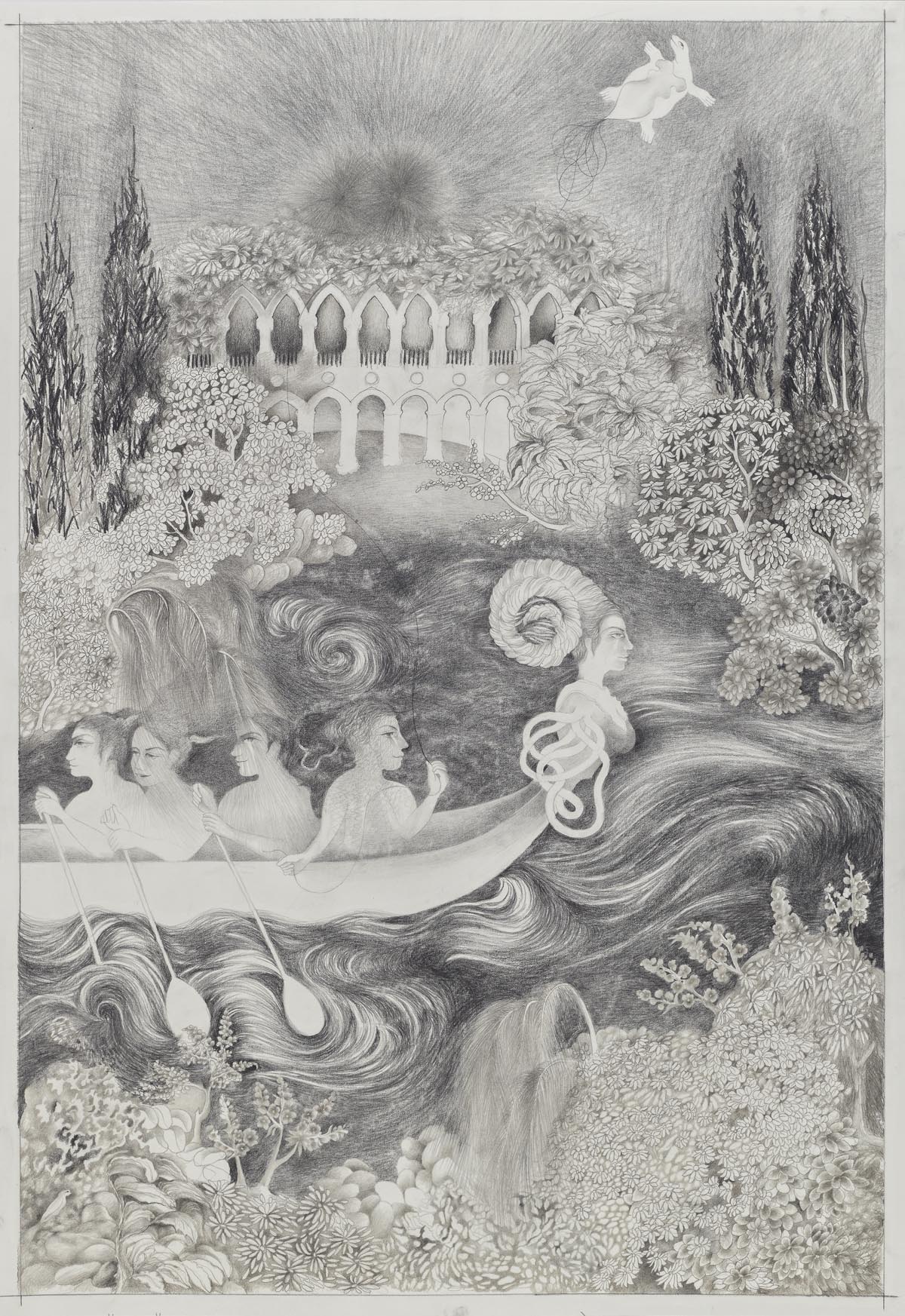
Shahzia Sikander (Pakistani and American, b. 1969), Gendered Currents: Gopi Regatta, 2024, graphite on paper, Lent by Kenneth J Birdwell
Hi, I’m Ainsley Cameron, the museum’s curator of South Asian Art, Islamic Art, and Antiquities and the curator of Shahzia Sikander: Collective Behavior. I am reading the “Collective Behavior at La Biennale di Venezia” section label.
This exhibition premiered as a Collateral Event of Venice’s Biennale Arte, the world’s largest gathering of contemporary art exhibitions. It was presented at the Palazzo Soranzo Van Axel, a fifteenth-century Gothic palace in Venice’s Cannaregio district. Installed within a series of stately rooms, Sikander’s artwork integrated seamlessly with the historic architecture, creating new and exciting visual connections between past and present.
Venice is the perfect location to explore Sikander’s artistic practice. There is a rich trade history between Venice, Asia, and the Middle East resulting in mixed and borrowed iconographies that reverberate through Italian Renaissance paintings, illuminated manuscripts of Central and South Asia, and textiles of the Islamic world. These histories are reflected in the exhibition’s newer works, including a selection of drawings and two glass artworks. Throughout this new body of work, Sikander examines the female form and feminine presence in art, religion, and society from a global feminist perspective.
The Venice iteration of Collective Behavior was co-organized by CAM and the Cleveland Museum of Art. This collaboration inspired the graphite drawing Gendered Currents: Gopi Regatta, where Sikander imagines water and land relationships through socio-political and climatic lenses while also announcing the arrival of a feminine entourage to Venice.






